
AAPM NEWSLETTER September/October 2023 | Volume 48, No. 5 IMPROVING HEALTH THROUGH MEDICAL PHYSICS AMERICAN ASSOCIATION of PHYSICISTS IN MEDICINE IN THIS ISSUE: ▶ President Elect's Report ▶ Treasurer's Report ▶ Development Committee Report ▶ Virtual Imaging Trials in Medicine ▶ Education Council Report ▶ MedPhys Match 2023 Special Report ▶ AAPM North Central Chapter Report ▶ 2023 Awards and Honors Ceremony ...and more! Special Interest Feature: Professional Mentorship Working Group
St. Louis, MO
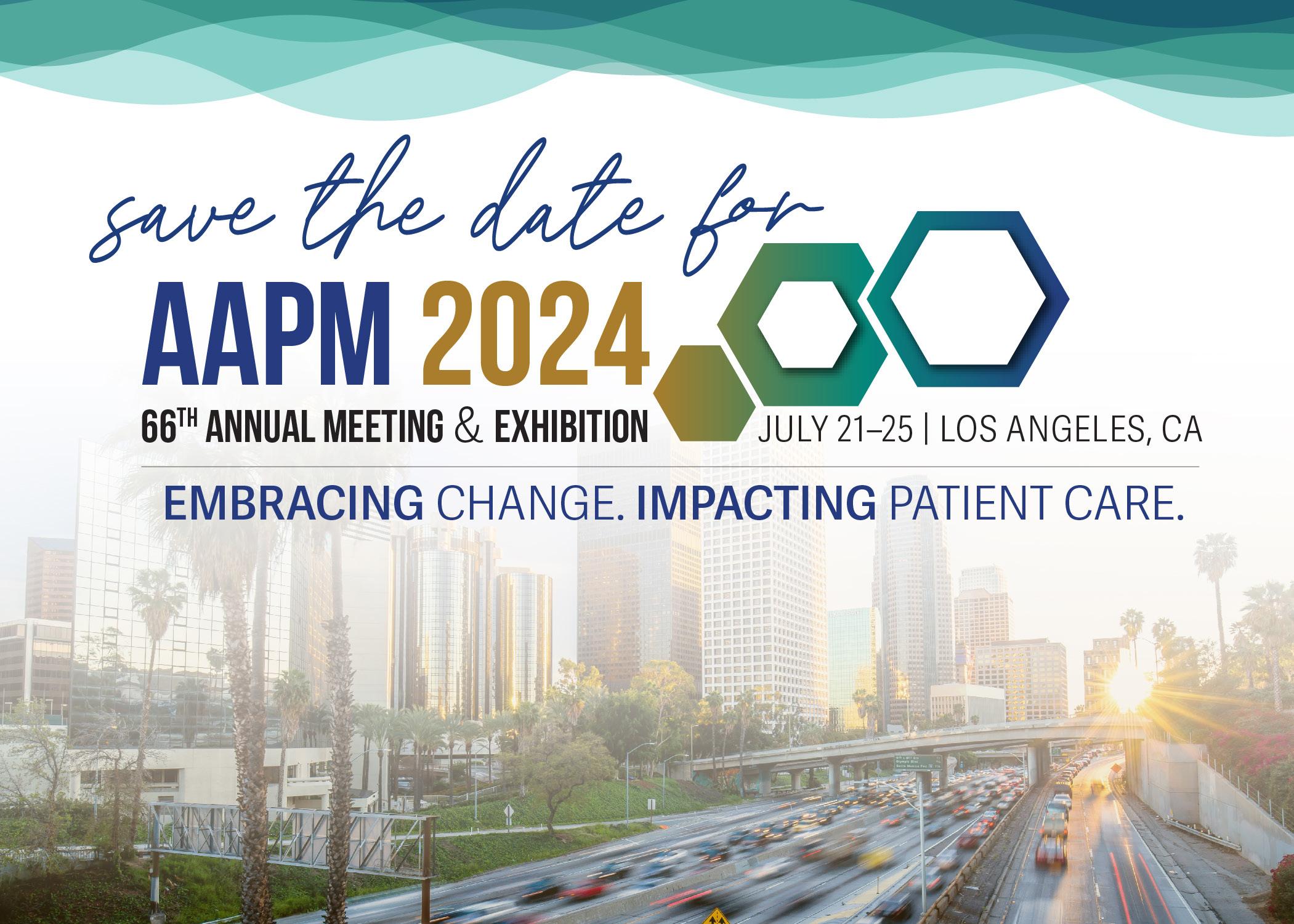

REPORTS IN THIS ISSUE
September/October
TABLE OF CONTENTS
EVENTS/ANNOUNCEMENTS
EDITORIAL BOARD
Jennifer Pursley, PhD, Editor Medical Physicist
Massachusetts General Hospital
Department of Radiation Oncology
55 Fruit Street
Boston, MA 02114 617-643-8273
newsletter@aapm.org
Eileen Cirino, MS
Irena Dragojevic, PhD
Yanle Hu, PhD
George Kagadis, PhD
Barbara Lilieholm, MS
Wei Liu, PhD
Joann Prisciandaro, PhD
Anna Rodrigues, PhD
SUBMISSION INFORMATION
To keep all reports uniform, we kindly request that submissions be made through a QuestionPro portal
Questions? Contact Nancy Vazquez
PUBLISHING SCHEDULE
The AAPM Newsletter is produced bi-monthly.
Next issue: November/December 2023
Submission Deadline: October 6, 2023
Posted Online: Week of November 4, 2023
CORPORATE AFFILIATE ADVERTISING
Advertising Rates & Deadlines
CONNECT WITH US!
EDITOR’S NOTE
I welcome all readers to send me any suggestions or comments on any of the articles or features to assist me in making the AAPM Newsletter a more effective and engaging publication and to enhance the overall readership experience. Thank you.
in Medicine
bi-monthly
AAPM
at
Street,
AAPM NEWSLETTER is published by the American Association of Physicists
on a
schedule.
is located
1631 Prince
Alexandria, VA 22314
2023 |
48, No. 5
Volume
5 Newsletter Editor's Report 7 President-Elect's Report 9 Executive Director's Report 13 Treasurer's Report 17 Development Committee Report 19 Legislative and Regulatory Affairs Report 21 Health Policy and Economic Issues Report 25 ABR Report 27 Updates from ACR HQ 29 Virtual Imaging Trials in Medicine 31 Special Interest Feature: Professional Mentorship Working Group 31 The AAPM Mentorship Program: Success Stories From Our First Year 37 Preparing For the First Mentorship Meeting 39 Education Council Report 43 MedPhys Match 2023 Special Report 47 ASTRO Update 51 Member Voices on Annual Meeting Boycott 55 AAPM Professional Behavior 57 AAPM North Central Chapter Report 61 2023 AAPM Awards and Honors Ceremony
4 Global Volunteer Information 6 AAPM Mentorship Program 12 2023 Awards and Honors Post-Ceremony Program Our Condolences 28 AAPM 2023 — Thank You! 30 2024 AAPM Funding Opportunities 36 Upcoming AAPM Webinars 38 AAPM Career Services 49 AAPM 2024 Summer School 50 2024 AAPM Expanding Horizons Travel Grant
Various initiatives within AAPM’s International Council (IC) are working to address needs and to enable knowledge exchange in the global medical physics community. To support these e orts, the Global Data and Information Exchange Commi ee (GDIEC) wants to facilitate excellent matches between requests from our global partners and AAPM member volunteers. GDIEC invites you to fill out a new section of the AAPM Member Profile indicating your
experience, volunteer interests, and regional/cultural preferences. This section of your profile is only visible to you and IC commi ee members, and you can update it at any time. While filling out the new profile section does not necessarily mean that you will be asked to volunteer, it allows members of IC commi ees to search for a great volunteer match for a given initiative or request.
If you are willing to volunteer, please fill the section that matches your specialty (you are welcome to complete multiple sections, if applicable).

NEW! Global Volunteer Information Section in Member Profile
h ps://www.aapm.org/memb/profile/gdiec_volunteer.asp
Goodbye Summer, Hello Fall!
Welcometo the September/October 2023 edition of the AAPM Newsletter!
I hope everyone had a wonderful summer, with some good weather, vacation, and family time to remember as we head into fall and back to school. Fall is my favorite season in New England and I’m looking forward to the cooler days and changing leaves. Before we say goodbye to summer, if you attended the AAPM Annual Meeting, remember to fill out your CEC Evaluation; the deadline for claiming credit hours is September 7. Attendees have access to the On-Demand content, so be sure to return to the Meeting Program Home page to watch the sessions you missed live; there was a lot of fantastic scientific, educational, and professional content, thanks to the efforts of all the Annual Meeting Program Directors. Please give a round of applause to AAPM Executive Director Angela Keyser and the amazing AAPM HQ staff who did a wonderful job organizing this meeting and keeping everything on track and running smoothly!
We have lots of fun and interesting reports for this edition of the Newsletter. Our Special Interest Group feature is from the Professional Mentorship Working Group, reporting the stories of several mentees and mentors in the AAPM Mentorship Program. It’s open to all AAPM members to participate as either a mentor or mentee, and you can join at any time! For those preparing to apply for residency positions this year, there’s a timely report on the perspectives and experiences of the 2023 MedPhys Match candidates. We also get to hear from one medical physics graduate program on how they succeeded in developing a community outreach program; it takes work and commitment but is very rewarding for all involved and hopefully, their story will inspire more programs to try. These are my highlights, but you will find many more important and informative reports in the full Newsletter!
All AAPM members are encouraged to submit content and ideas for the Newsletter either directly to the Editor or through the submission link on the Newsletter page. If you have an announcement of an honor or award that you would like to share, please submit it to the Newsletter for consideration! My goal is to have something of interest to every AAPM member in each edition of the Newsletter, and that’s only possible with the help of all members. Enjoy this issue of the Newsletter and send us your feedback and ideas for future editions. And please share the Newsletter articles you enjoy with your social media network; the Newsletter is available for all to read. ¢
Jennifer Pursley, PhD Massachusetts General Hospital
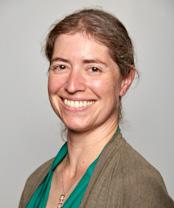
www.aapm.org | 5 AAPM Newsletter | September/October 2023 Volume 48, No. 5
NEWSLETTER
EDITOR’S REPORT
AAPM Mentorship Program: Volunteers Needed!
The AAPM Mentorship Program is actively recruiting volunteers from all disciplines, work environments and education levels to serve as mentors to other AAPM members. Participation is open to any AAPM member. More details including an FAQ and sign up can be found here.

What Mentorship IS
Mentorship is one-on-one, virtual, or in person. The AAPM Mentorship Program is not just for professional mentorship, it can be used to support any form of personal or career development, including navigating an early career post-residency, being more productive in research and grant writing, how to climb the academic ladder, becoming a better educator, strategizing career changes and moves, management and leadership skills, or even retirement! The individual aims of the mentoring relationship are up to the participants.
What Mentorship is NOT
This is not a clinical training program. Mentorship o ers a personalized opportunity to work on your individual career development goals, develop new skills and expertise and access objective evaluation of your performance from an experienced member of AAPM. Mentorship can increase your networking opportunities, help to clarify your career direction, and provide support and motivation in meeting the challenges of work and home life.

August 2023

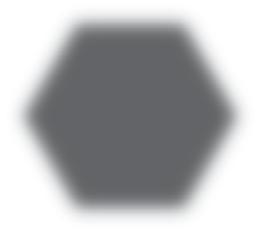
PRESIDENT-ELECT’S REPORT


2023 Annual Meeting in Review
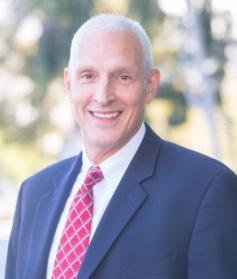
The 2023 Annual Meeting brought together researchers, clinicians, and industry leaders from around the world to share novel research, best practices, and technological advancements. Held July 23–27, 2023, the conference provided a platform for participants to exchange knowledge, collaborate, and discuss the latest developments in medical imaging, radiation therapy, and emerging areas where physicists can impact human health. The meeting theme chosen by Ehsan Samei, PhD, The Art of Science, The Science of Care, challenged us to think about how our profession is informed and energized by our humanity. This is a perspective that gives us new resources in our science and practice, and helps us to have a more fulfilled connection to our peers, our vocation, and our patients.
The meeting showcased a wide array of cutting-edge research and clinical applications. One of the major highlights was a Specialty Program on the emergence of artificial intelligence (AI) in imaging and treatment planning. Modalities such as hybrid imaging and treatment systems were discussed and provide exciting new possibilities for localization and treatment. Ensuring patient safety and treatment efficacy remained a key focus at the Annual Meeting. Sessions were devoted to quality assurance practices, dosimetry, and treatment verification techniques. Researchers and clinicians emphasized the importance of rigorous safety protocols and the use of advanced monitoring tools to minimize errors. We also learned of the emerging role of medical physicists in surgery.
Apart from scientific advancements, the conference also provided opportunities for professional development and education. Sessions covered a wide range of topics, including best practices in clinical medical physics, career development, and leadership in the field. The Annual Meeting also featured an extensive industry exhibition showcasing the latest medical physics equipment, software, and services.
The 2023 Annual Meeting was an outstanding event that celebrated remarkable progress in the field of medical physics. The conference served as a powerful reminder of AAPM's dedication to advancing medical physics, enhancing patient outcomes, and shaping the future of healthcare through collaborative efforts and a strong commitment to scientific excellence.
Lastly, I would like to extend our heartfelt gratitude to the AAPM staff, the leaders of the meeting program (Ingrid Reiser, Annual Meeting Subcommittee Chair and Kristy Brock, Annual Meeting Subcommittee Vice-Chair), and all the members of the 2023 Annual Meeting Program Working Groups for their exceptional efforts in organizing this stellar meeting.
www.aapm.org | 7 AAPM Newsletter | September/October 2023 Volume 48, No. 5
Todd Pawlicki, PhD, FAAPM UC San Diego Health
Looking Ahead to 2024 and Our Next Annual Meeting
Medical physicists and AAPM have traditionally focused on specialized areas such as radiation therapy, diagnostic imaging, nuclear medicine, and radiation safety, which are essential to healthcare. However, there is an opportunity for a more extensive impact by applying their expertise in physics, mathematics, engineering, data analysis, and analytical thinking to other medical domains.
To achieve this, changes within AAPM and the medical physics community are necessary. Currently, their focus primarily caters to the traditional medical physics fields, evident in their structure, processes, publications, conferences, certifications, and education. Broadening their scope to encompass all areas of healthcare could attract a diverse group of like-minded individuals, fostering collaborations across disciplines and ensuring even more meaningful contributions to patient care. Creating new training tracks for students and residents will prepare the next generation for this broader mandate. Embracing the evolving landscape is essential for medical physicists and AAPM to maintain and expand their impact on healthcare.
I have proposed that we continue on this journey of change together in 2024 at our next annual meeting. The meeting to be held July 21–25, 2024 in Los Angeles, CA will focus on adapting to changes within both healthcare and AAPM to have the highest possible impact on patient care.
In 2024, AAPM will go through a significant transformation with the appointment of a new Executive Director.
While we celebrate Angela Keyser and her 30 years of service to AAPM and the profession, this change presents an opportunity to reassess the strategies and operations of AAPM as an organization.
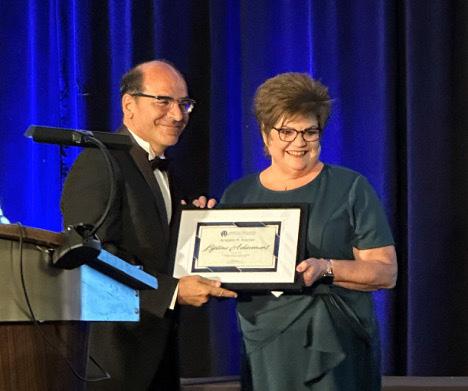
During the next year and at the next Annual Meeting, we will engage in discussions to identify areas within our association that can benefit from changes and work together to implement those changes for the betterment of the members and the association. Our main goal is to understand and adapt to these changes ensuring continued cutting edge research and influence on the future of healthcare.
Emphasis for My Year as AAPM President: Board Engagement
Over the past 10 years, I have progressed from serving as a Member-at-Large on the Board of Directors to becoming the Secretary of the Executive Committee about 5 years ago. Throughout this time, I have gained valuable insights into how AAPM functions. I believe that the association is not fully capitalizing on the collective wisdom of its 45-member Board of Directors.
As I prepare to take on the role of President in the coming year, my primary focus will be on increasing engagement of AAPM's Board of Directors. The active involvement of the Board is crucial in providing strategic direction, oversight, and support to the management team. To achieve this, I will work on improving communication channels and fostering two-way communication between the management team and the Board. I will consistently encourage Board participation and create an environment where all board members are motivated to actively engage in decisions about the association. I understand that this will be challenging, but I am confident that it will ultimately lead to a more engaged Board of Directors, allowing us to harness the knowledge and expertise of its directors to drive the organization's success.
Adapting to change is crucial for the ongoing advancement and well-being of our association and the medical physics profession as a whole. I am eager to collaborate with all of you to ensure that medical physicists and AAPM remain at the forefront of patient care and innovative research for years to come. Together, we will propel our association forward. ¢
8 | www.aapm.org AAPM Newsletter | September/October 2023 Volume 48, No. 5 PRESIDENT-ELECT'S REPORT , Cont.
AAPM Executive Director, Angela Keyser, receiving a Lifetime Achievement Award at the 2023 Annual Meeting.
Information from HQ
EXECUTIVE DIRECTOR'S REPORT
New AAPM Reports:
• Report No. 307 — Use of electronic portal imaging devices for pretreatment and in vivo dosimetry patient-specific IMRT and VMAT QA
• Report No. 372 — AAPM WGDCAB Report 372: A joint AAPM, ESTRO, ABG, and ABS report on commissioning of model-based dose calculation algorithms in brachytherapy
RSNA 2023 — Leading Through Change
Register now for the RSNA 109th Scientific Assembly and Annual Meeting, to be held November 26–30, 2023. AAPM Members must register by October 4 to receive complimentary registration for the physical meeting. There is a charge for virtual access.
RSNA/AAPM Symposium: Together We Can Make a Difference
Plenary session
Thursday, November 1 | 11:00 AM–12:00 PM, CT
The RSNA/AAPM Symposium will focus on successful collaboration between radiologists and physicists in technical developments and clinical translations in medical imaging.
International Day of Medical Physics on November 7
To raise awareness about the role medical physicists play for benefit of patients, IOMP organizes annually the International Day of Medical Physics (IDMP) on November 7, an important date in the history of medical physics. On that day in 1867, Marie Sklodowska-Curie, known for her pioneering research on radioactivity, was born in Poland. We celebrate the 11th IDMP on November 7, 2023. The theme of IDMP 2023 is "IOMP’s 60th Anniversary: Standing on the Shoulders of Giants”. This is an excellent opportunity to promote the role of medical physicists. Visit the IOMP website for more information.
AAPM’s HQ Team…At Your Service!
Jaxon Levi Priestly arrived on Wednesday, April 26 to AAPM Accounting Assistant Janelle Priestly, her husband, Darryl, and big brother, Justin. Jaxon arrived a bit early, but at 10 weeks he was able to go home at a whopping seven pounds! Janelle has returned to work, at a reduced level for a bit, and the team joins the Priestly family in celebrating Jaxon’s big wins.
I am pleased to report that we on-boarded 4 new team members in the second quarter:
• Patricia Lavey, our new Office Services Assistant is our “first line of defense” responsible for answering the main phone line and handling general inquiries. In addition, AAPM groups should contact Patricia for assistance with setting up Zoom meetings.
Angela R. Keyser AAPM
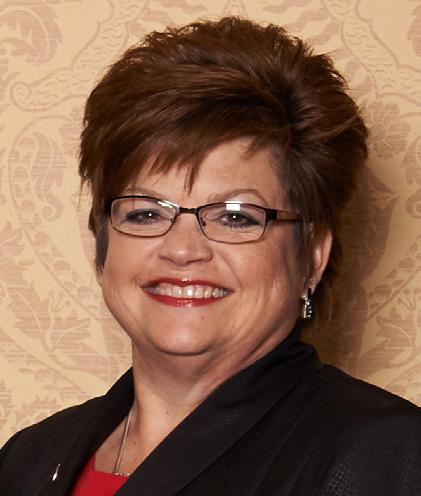
"I am reminded that success is not an individual endeavor. And, I am truly blessed to have a second family — that of our AAPM HQ Team. You all continue to amaze me. Thank you. I am grateful for our opportunities to create, innovate, and challenge ourselves. Being part of this team that we’ve created will forever be one of my most cherished things."
Who does what on the AAPM HQ team? See a list with contact information and brief descriptions of responsibilities online An organization chart is also provided. We also provide information about the diversity of our team as welll
www.aapm.org | 9 AAPM Newsletter | September/October 2023 Volume 48, No. 5
• David Crowley is our new Senior Government Relations Manager and holds the title of "First Medical Physicist on the HQ Team!" He holds a BS in Physics from Case Western Reserve University, an MS in Medical Physics from Georgia Institute of Technology, and later this year will have his MBA from the University of North Carolina at Chapel Hill.
• Angela Dombroski is our new Web Administrator, responsible for maintaining the AAPM website as well as related sites. She is well known to many of us from the days when we were headquartered in Maryland, as she was part of the AIP team for over 19 years.


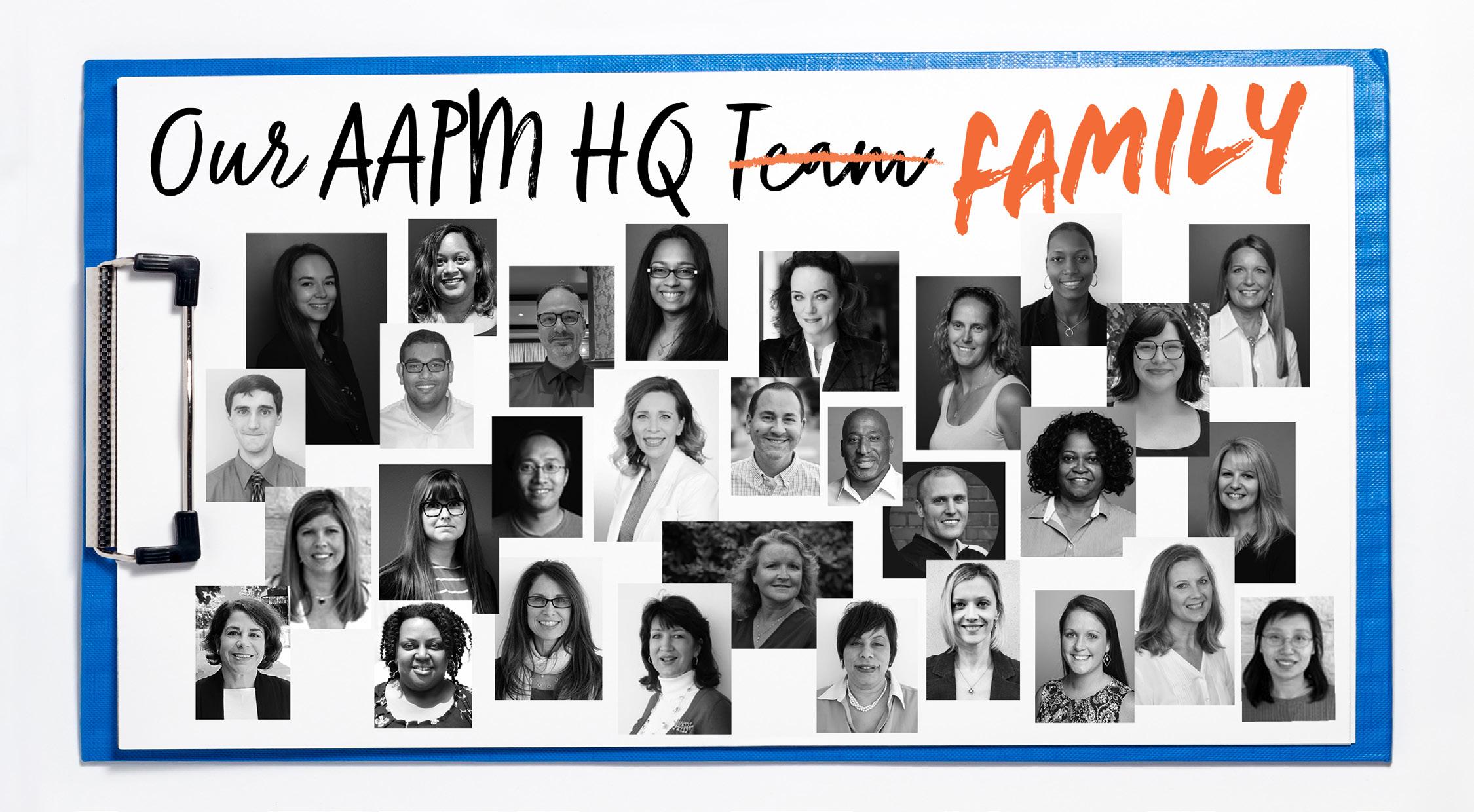
• Myron Zambrano, our new Applications Developer, comes to us with extensive experience as a Software Engineer/Applications Developer. He is responsible for design and implementation of new and existing database programs.
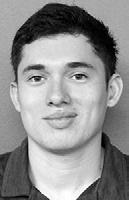
10 | www.aapm.org AAPM Newsletter | September/October 2023 Volume 48, No. 5 EXECUTIVE
DIRECTOR’S REPORT , Cont.
Reflections on my Last Annual Meeting as Your Executive Director
I find myself filled with a mix of emotions, as I reflect on the last annual meeting I had the privilege to lead as the Executive Director of AAPM. The annual meeting was more than just a gathering; it was a celebration of collective efforts, a time to honor the milestones we've achieved together. Two of the highlights of the event for me were receiving the AAPM Lifetime Achievement Award and being honored during the Leadership Reception. It was a surreal experience for me, listening to the accolades and appreciation expressed by many, both volunteers and the HQ team. It was an experience that one cannot even imagine, and I am truly humbled and filled with such gratitude and thankfulness. I want to share the comments and reflections I offered during the Awards and Honors Ceremony.
Acceptance Speech Upon Receiving the AAPM Lifetime Achievement Award
Monday, July 24, 2023 | Houston, TX | AAPM 65th Annual Meeting and Technical Exhibition
Good evening,
I stand before you today, deeply humbled, and profoundly honored. But I must say, I would be much more comfortable in my white staff shirt helping to line up the processional than I am standing before you right now!
When I began my AAPM journey on November 1, 1993, I had no idea what a great experience lay ahead for me. And honestly, I had no expectation that it would last for 30 years.
None of this would have been possible without the support of my family. First, to my parents Robert and Ruth Todd. Thank you for instilling in me the values of hard work, perseverance, and compassion. Your unwavering encouragement and belief in me have been instrumental in shaping who I am today. I am so thankful to have my husband of 31 years, Jimmy Keyser and our daughter, Dr. Kaitlyn Keyser, with me to share in this wonderful moment. Our son Korey and his wife Ariann were not able to be with us this evening, but I appreciate their support from afar!
My family has shared the highs and lows, celebrated my victories, and provided comfort during moments of doubt. Their love, understanding, and sacrifice have been the bedrock of my journey. I am forever indebted to them.
I am reminded that success is not an individual endeavor. And, I am truly blessed to have a 2nd family –that of our AAPM HQ Team. You all continue to amaze me. Thank you. I am grateful for our opportunities to create, innovate, and challenge ourselves. Being part of this team that we’ve created will forever be one of my most cherished things.
I would be remiss not to mention my mentor and AAPM’s previous Executive Director Sal Trofi. He is the one who set me on this path. Thank you, Sal, for bringing me to AAPM and for always encouraging me to grow! I will also be forever grateful to AAPM’s previous Director of Meetings and Programs, Lisa Rose Sullivan who retired at the end of 2021. Lisa and I both began our AAPM journey on the same day. Over the years, I came to rely on Lisa’s input and sage advice as we’ve talked through many a challenge and then rolled up our
sleeves to work side-by-side to get the job done!
I also owe a debt of gratitude to the countless AAPM leaders and volunteers who have guided and supported me throughout the years. My heartfelt appreciation for the unwavering belief in my abilities. I have such memories…and STORIES…. to last a lifetime.
So, what is next for me? Jimmy and I plan to travel the country in our motorhome fulltime…until it isn’t fun anymore and we decide to put down roots once again. But I am taking on a new role when I retire… that of GRANDMOTHER (or GiGi as I hope to be called!). Korey and Ariann announced on Father's Day that they are expecting our first grandbaby, a grandson – Evander Steele Keyser at the end of the year. Jimmy and I are beyond thrilled! The motorhome will be seeing a bunch of time in Pennsylvania I expect.
In closing, I’ve spent over half my life as part of this amazing organization. To be recognized in such a way is a moment that I will forever cherish. Thank you once again for this incredible honor. ¢
www.aapm.org | 11 AAPM Newsletter | September/October 2023 Volume 48, No. 5 EXECUTIVE
DIRECTOR’S REPORT , Cont.
2023 Awards P t-Ceremony Program
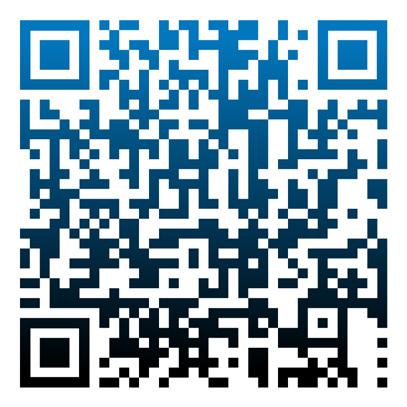


See the complete program here:
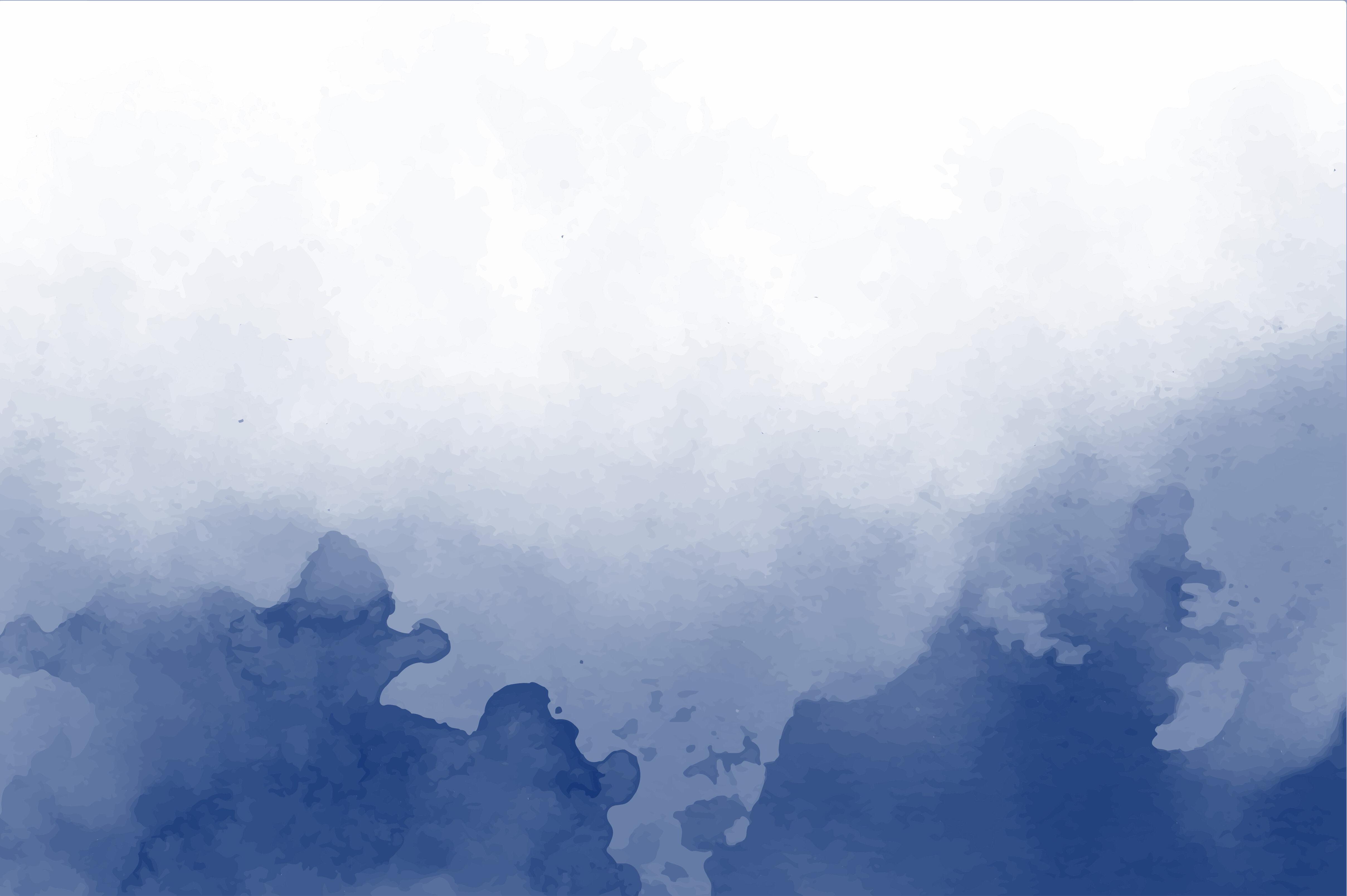
AAPM 2023 Mid-Year Financial Report
TREASURER'S REPORT
Havingrecently returned from the 2023 AAPM Annual Meeting in Houston, I am very encouraged. It was great to meet in-person with colleagues and discuss issues vital to the future of AAPM and the medical physics profession. From the perspective of both numbers (registration) and programming, the meeting was very successful — this success was the result of tremendous effort across a team of volunteers and Headquarters staff. It was especially encouraging to see that our in-person registration numbers exceeded the number of people who attended last year in Washington, DC. In my role as Treasurer, it was a pleasure to share with many of you during our Annual Business Meeting the positive financial results from 2022, which is the topic of this column.
2022 Audited Financial Results
AAPM finished 2022 with a surplus from operations of $46,150 (Figure 1). The 2022 budget (approved by the Board in November of 2021) reflected a deficit of $1,501,204, so 2022 ended with an overall favorable variance of $1.55M. The largest single driver of this favorable variance (accounting for approximately $784k) was under-spending by councils and committees; additionally, headquarters overhead expenses were below budget by nearly $317k due to salary and benefits savings realized due to several open staff positions during the year as well as a positive variance in the actuarily computed post-retirement benefits calculation. On the revenue side, Placement Service revenue exceeded budget by $144k, and Online Learning Service (RDCE) revenue exceeded budget by $138k.
AAPM’s balance sheet remains strong at the end of 2022, with total assets exceeding $27.8M (Figure 2)—a $3.6M decrease from the prior year. This decrease was primarily driven by the decline in investments as a result of the bear market experienced in 2022. For the year, total investments were down $3.9M.
2023 April Interim Results
Using a statistical model based on historical budgets and operating results, the 2023 budget was approved with a deficit of $1.8M. This deficit, however, was materially higher than that indicated by the model. Due to potential ramifications of the 2023 meeting locations, registration and exhibitor revenue for the Annual Meeting and Spring Clinical Meeting were reduced in the 2023 budget by 20% and 10%, respectively, which contributed to the higher-thannormal budgeted deficit.
The AAPM’s 2023 balance sheet as of April reflects a modest increase (0.6%) over the prior year. A portion of the recovery can be attributed to investments, which are up 1.2% over the prior year as the market has begun to bounce back from a challenging year in 2022.
Samuel G. Armato III, PhD The University of Chicago

www.aapm.org | 13 AAPM Newsletter | September/October 2023 Volume 48, No. 5
Currently, the Association is working on the 2024 budget. All councils and committees have been invited to prepare their respective budgets, which they will submit by the end of August. Historically, a significant part of the AAPM budget and financial reporting centers around the underspending within councils and committees (remember that the councils underspent by approximately $784k in 2022). In an attempt to shift the mindset of deficit-based budgeting that depends on this magnitude of underspending to avoid a massive actual deficit in operations at the end of the year, we are attempting to “Do Less Better” with our budget process by shifting the foundation for budget preparation from actual past budgeting to actual past spending. The phrase “Do Less Better” is one that I have been hearing among Board members in other contexts, from AAPM administrative efficiency to subgroup formation. The idea is simple: we as people can only do so much given constraints on
the greatest of all resources (our time), and AAPM, as a volunteer-driven association, can only hope to achieve a limited number of goals and objectives in any given year. Since every dollar in a budget represents an activity in which HQ staff or member volunteers will need to be engaged, the do-less-better approach to budgeting seeks to include on the expense side of the budget only those activities that we reasonably expect are achievable during the upcoming year; past actual spending then becomes the basis for the budget rather than a much more sizably priced wish list of well-intended (but not achievable) activities. This change in our culture will help move AAPM towards a more balanced budget. While we do not intend to achieve this goal in one year, this paradigm shift will help position AAPM for the future.
Included for informational purposes are (1) the five-year trend of operating revenues and expenses (Figure 3) and
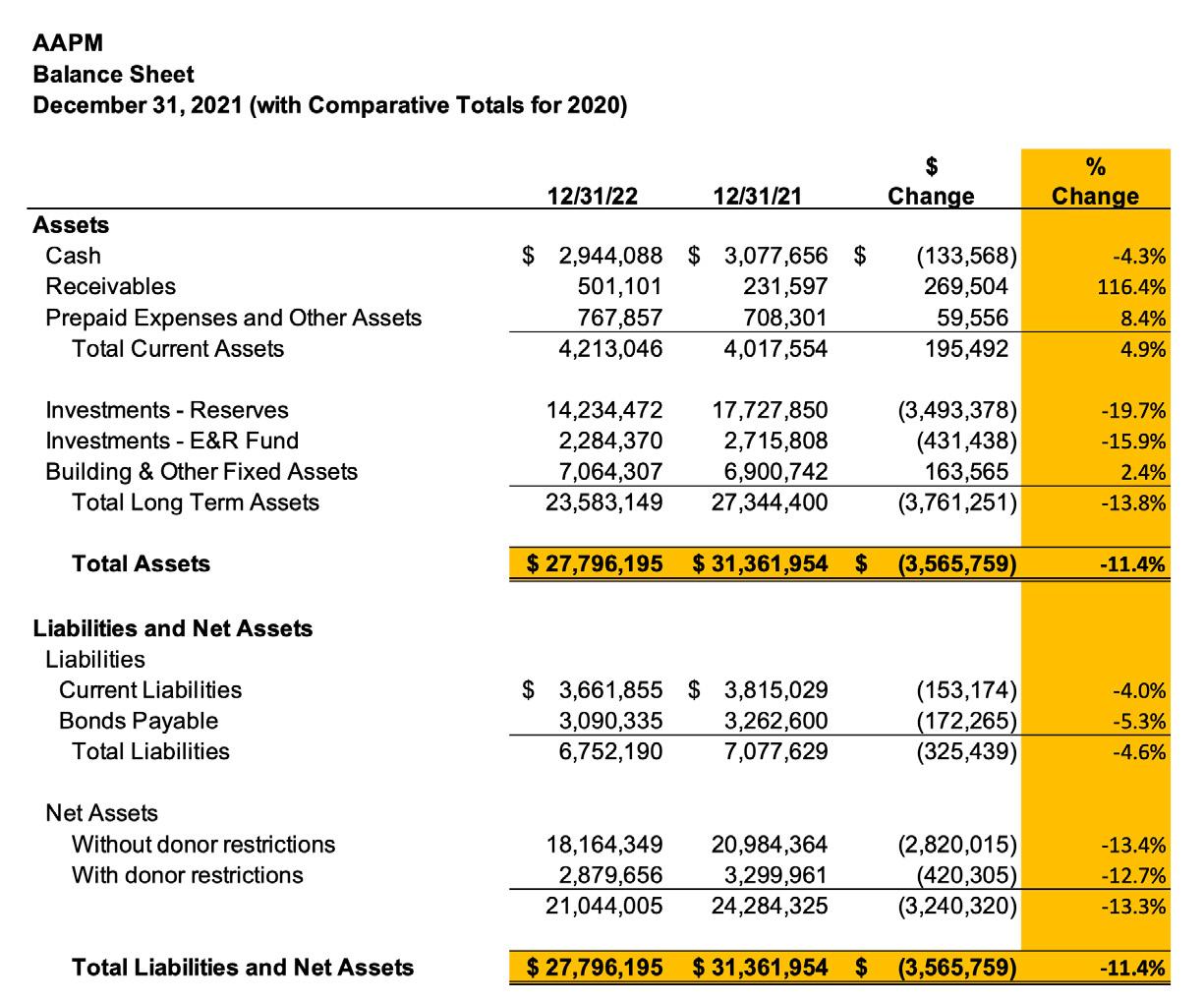

14 | www.aapm.org AAPM Newsletter | September/October 2023 Volume 48, No. 5 TREASURER'S REPORT , Cont.
Figure 1: AAPM income and expenses for 2022
Figure 2: AAPM balance sheet
(2) the five-year trend of income (loss) from operations (Figure 4). These charts show the operating income, investment income, unrealized gains (losses), and the Education and Research Fund net activity for the past five years. I wish to highlight that in 2021 AAPM had net income from operations in the amount of $714k; however, as previously communicated, one of the biggest contributors to this surplus was the PPP loan forgiveness ($615k). Figure 4 shows the impact on operational income of this onetime outlier: over the past five years the Association has
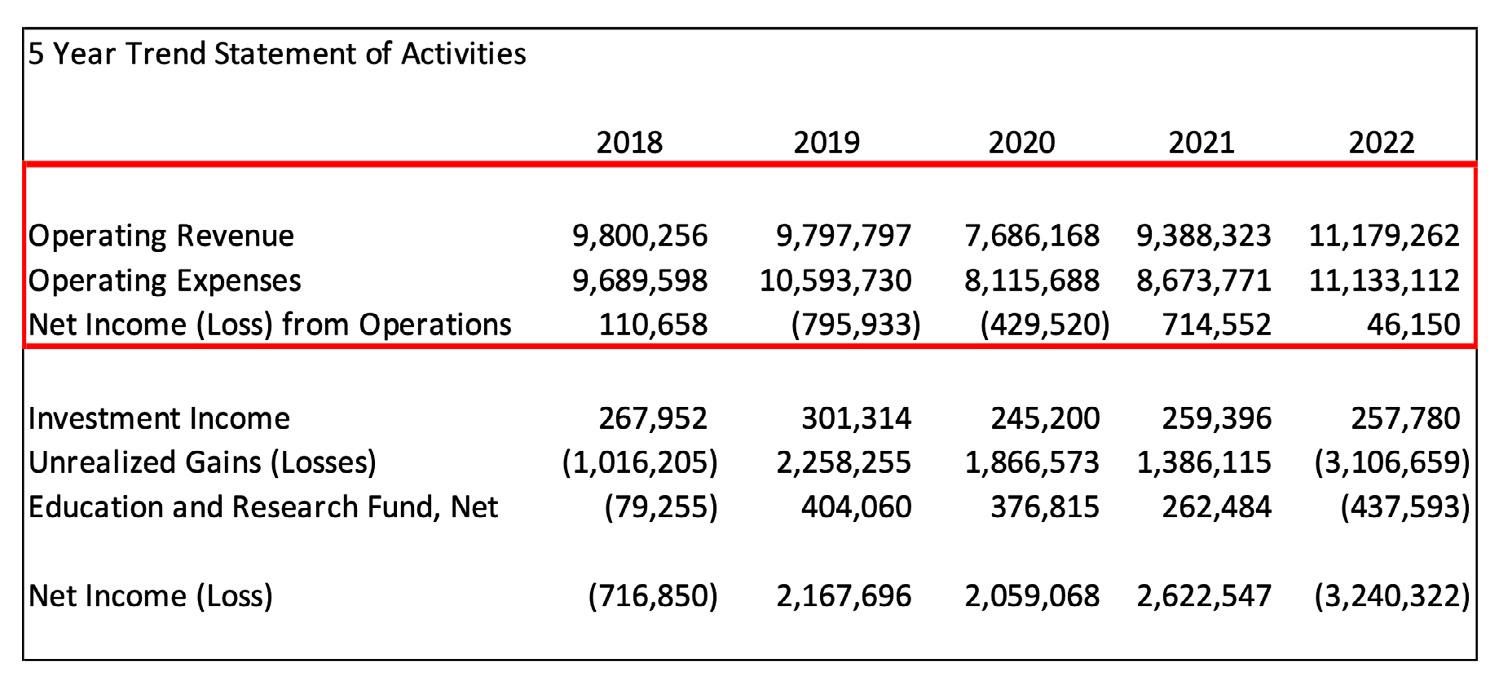

generated an operating deficit of approximately $354k, but without the PPP loan forgiveness, AAPM has generated an operating deficit of $969k over the past five years. The Association, however, has begun to turn the tide, generating operating surpluses each of the past two years.
I would like to thank Robert A. McKoy, CPA (AAPM Finance Director) for his essential subject matter contributions to this column. I also want to thank the entire AAPM finance team for their skilled stewardship of AAPM finances. ¢
www.aapm.org | 15 AAPM Newsletter | September/October 2023 Volume 48, No. 5 TREASURER'S REPORT , Cont.
Figure 4: Five-year trend income (loss) from operations
Figure 3: Five-year trend operating revenues and expenses
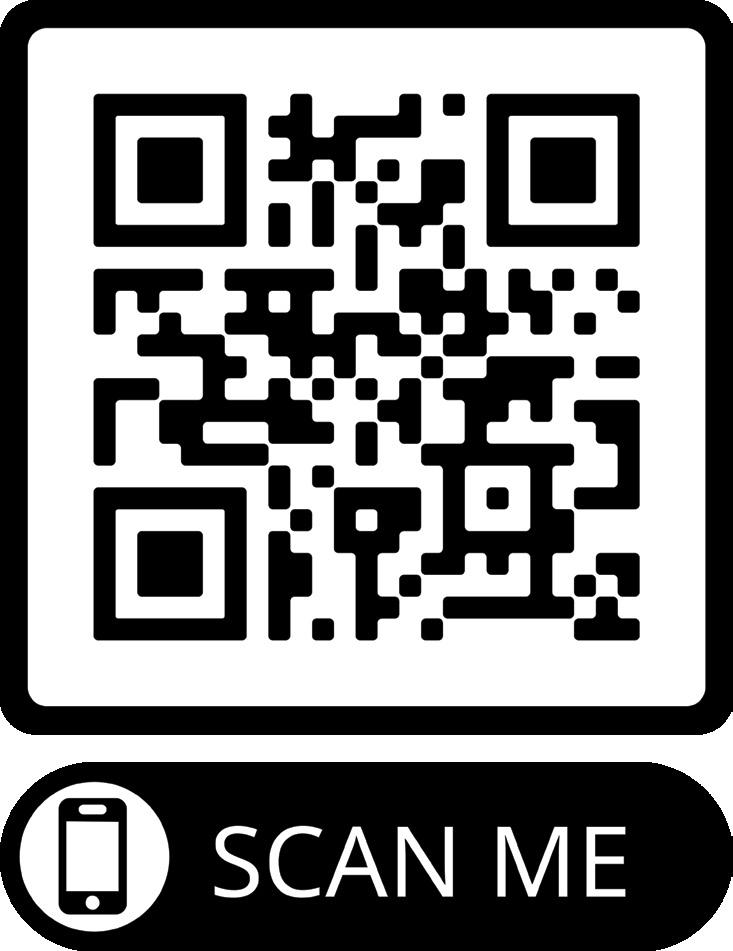
Embracing innovation. Enhancing outcomes. REGISTER NOW Varian User Meeting September 30
Parting Words from the Chair of the Development Committee
As I complete my final months as chair of our AAPM Development Committee (DEV), I thank AAPM for the opportunity and joy of serving the past six years in this capacity. Furthermore, I challenge AAPM members to join me in donating to our Education and Research (E&R) Fund. AAPM’s development efforts are a major operation, which require a team effort, and for that I thank all AAPM headquarters staff (particularly Justin Stewart, Abby Pardes, and Robert McKoy), DEV members, and donors to the E&R Fund. The E&R fund is a portfolio of multiple funds that support AAPM education and research awards and honors, and I refer you to our 2022 AAPM Education and Research Fund Annual Report for details and recipient stories.

E&R Fund Awards and Honors
E&R Fund awards and honors are only possible because of the approximately 2,100 members, companies, and professional societies that have donated to our E&R Fund. As of December 31, 2022, the E&R Fund had a balance of $2.84 million. In 2022, it supported 89 awards and honors, whose $523,000 costs were shared by the E&R Fund (44%) and operating budgets of Education Council and Science Council (56%).
The Challenge
Each year our AAPM Education and Research Fund Annual Report recognizes E&R Fund donors to date. Cumulative donor levels are partitioned as either Diamond ($20,000 or greater), Platinum ($10,000-$19,999), Gold ($5,000$9,999), Silver ($2,500-$4,999), Copper ($1,000-$2,499), Bronze ($500-$999), or other ($499 or less). As I have a better appreciation of our AAPM awards and honors after serving my two 3-year terms, I am making a donation this year to achieve my next donor level. I challenge each member to achieve their next donor level (or higher) or to become a first-time donor through a one- to fiveyear donation. Your cumulative donations to date can be found at the top right of your landing page on the AAPM website
Why Now?
Increased funding will allow an increased number of research seed grants, graduate fellowships, and other awards and honors. There is no better time than now to donate: AAPM’s Policy 95 states that AAPM will match any “donation of at least $2,500, either through a one-time donation or a fiveyear or less pledge. AAPM will match each payment you make. Your donor level will immediately reflect the total amount pledged plus the total amount matched.” For example, if you pledge to pay $500 per year for the next five years, the E&R Fund will increase $5,000, and you will be recognized for a $5,000 donation, instantly making you at least a Gold level donor
www.aapm.org | 17 AAPM Newsletter | September/October 2023 Volume 48, No. 5
DEVELOPMENT COMMITTEE REPORT
Ken Hogstrom, PhD
LSU & Mary Bird Perkins Cancer Center
How to Make Donations
Donations are made to one or more funds within the E&R Fund portfolio, e.g. general, memorial, named, international, or other funds. Currently, our general restricted fund (non-endowed) supports research seed grants and graduate student fellowships, which AAPM would like to increase. Our general endowed fund helps seed new endowed funds, such as those used for our journal and innovation in medical physics education
awards. Go to the Donate Now web page to investigate your fund options. Donations can be made online or by check, the latter often useful for making qualified charitable contributions.

For further details or questions feel free to contact our headquarters support, Justin Stewart, or me
AAPM is a 501(c)(3) organization (EIN: #23-7057224); donations are tax deductible to the full extent of the law. ¢



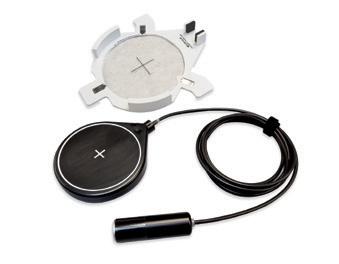

Touches the
AAPM Newsletter | September/October 2023 Volume 48, No. 5 DEVELOPMENT COMMITTEE REPORT , Cont.
Features: • Simple to use – Accurate and reliable • Customizable Touch Screen • Wi-Fi and USB Computer Connectivity • Report Generation DAP For further details: Contact us at +1 (626) 357-7921, sales@radcal.com or www.radcal.com Need to check the performance of X-ray machines? Then the Radcal Touch meter is your tool of choice.
World! Visit us at RSNA Booth #3312, 11/26 -11/30 vc AAPM Clr Ad 7.5x4.875_23Aug04.pdf 1 7/7/23 12:28 PM
Radcal
AAPM Takes Aim at Helping Medical Physicists Find a Voice
LEGISLATIVE AND REGULATORY AFFAIRS REPORT
Atthis year’s annual meeting in Houston, the Government and Regulatory Affairs Committee (GRAC) hosted a symposium session entitled “Engaging in Advocacy with Legislators and Regulators. Why Should Medical Physicists Care?” Kathleen Hintenlang, PhD and Kevin Little, PhD moderated the session early Tuesday morning. Despite the time, an encouraging number of attendees showed up interested in learning about this important topic. Speakers included Sebastien Gros, PhD, GRAC Chair; Matt Reiter, Principal and Partner with Capitol Associates, Inc.; and David Crowley, Senior Government Relations Manager at AAPM.
Sebastien began with an overview of GRAC’s organizational structure, its position within the Administrative Council, and key subcommittees. He led the audience through operational activities, such as responding to regulatory requests for information or interfacing with peer organizations that share interests for radiation in medicine. GRAC provides vital support for our members by advocating for beneficial rules and legislation (i.e., medical physics licensure programs) or by opposing harmful policies. Examples of topics GRAC is currently examining are included in the table below:
NRC: FDA: CMS:
Medical Use of Isotopes IEC Standards Transition
Reimbursement and Payments Boards, Training, Experience Rulemaking
Extravasations
Patient Release (RG 8.39)
Classification of Devices
Network of Experts
Source Security Guide Documents: MR Safety and Performance

Emerging Technology
Developing Electronic Clinical Quality Measures (eCQM)
NIH/DOE/Research:
Data Sharing
Office of Science and Technology Policy (OSTP): Research Funding Programs
Data Access Cancer Moonshot Initiative
Research Environment and Security
Source Replacement and Security
David Crowley Senior Government Relations Manager, AAPM
GRAC activities build external awareness and a reputation for AAPM, our members, and a physicist’s role in research or healthcare. Sebastien cautioned the audience with a reference to Hamilton, saying, "AAPM needs to be 'in the room where it happens' when decisions are made affecting medical physicists. Or... the importance of advocacy and how we can practice it simply on a day-to-day basis by starting small and discussing the profession, career pathways, and the critical roles medical physicists play with those around us in everyday life. Afterall, your friends, family, neighbors, and other community members are voting constituents."
www.aapm.org | 19 AAPM Newsletter | September/October 2023 Volume 48, No. 5
GRAC activities build external awareness and a reputation for AAPM, our members, and a physicist’s role in research or healthcare. Sebastien cautioned the audience with a reference to Hamilton, saying AAPM needs to be “in the room where it happens” when decisions are made affecting medical physicists.
Matt painted a picture of the congressional landscape, providing specific detail on areas of interest to AAPM. A primary takeaway is that the House and Senate are controlled by Republicans and Democrats, respectively. This makes passing legislation more difficult unless it is introduced with strong bipartisan support. Matt shared insights on current congressional activities and how they may affect medical physicists, these included:
• Veterans Affairs Therapy Medical Physics Salary Cap — See May/June 2023 Newsletter;
• Extravasation Legislation—Advising against unrealistic legislation;
• Debt Ceiling Agreement—Impacts on reduced federal spending;
• Cancer Moonshot Initiative;
• ARPA-H—A subset but independent research arm of NIH;
• Inflation Reduction Act—Medicare Part D drug pricing;
• Source Security;
• Healthcare Workforce; and
• Big Data/AI.
David focused on the importance of advocacy and how we can practice it simply on a day-to-day basis by starting small and discussing the profession, career pathways, and the critical roles medical physicists play with those around us in everyday life. After all, your friends, family, neighbors, and other community members are voting constituents. One day, they themselves could serve as a lawmaker. Everyday conversations will build familiarity across the population for when it matters most. Successful advocacy by our members will keep medical physics top-of-mind as a recognized healthcare and research profession, will promote inclusion and help our members find a voice (empowering individuals both professionally and personally), and will strengthen the respect for AAPM and its causes.
The healthcare system is diverse and is home to many different players. David discussed the 5 P’s: producers, providers (or in our case, physicists), payers, policy makers, and patients. Let’s face it: patients should be at the center, but everyone has their unique perspective. Healthcare,
particularly in the U.S., will face significant challenges in the years to come. Only by engaging all participants in this system will AAPM be successful in our strategic and regulatory goals.
The session also introduced the AAPM State Champions Program. Due to the diverse and complicated regulatory environment facing our members, varied at every state and jurisdiction, GRAC is initiating the state champions concept as a grass roots effort to affect change. These champions will be directly involved with legislative or rulemaking efforts important to the AAPM members of that locality.
Champion volunteers were sought through the different AAPM chapters until the time of the annual meeting. Currently, a little over half of the states have volunteers. Ideally, there will be at least one imaging and one therapy physicist per state, and thus there is still opportunity to get involved. The below image shows states with volunteers (gray) vs. those still needing volunteers (blue). Email your chapter leadership to request a nomination for your state’s champion roles or reach out to david@aapm. org directly for more information. GRAC plans to begin hosting activities and workshops in late 2023 for the state champions.
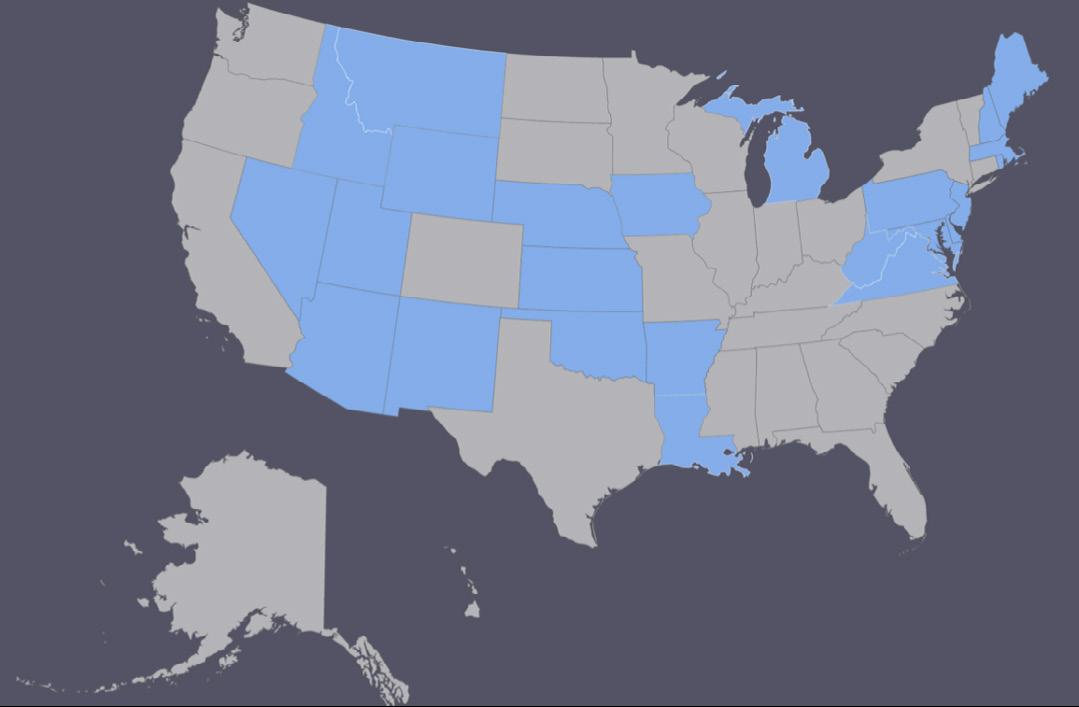
If you missed the advocacy session, you may watch it with your meeting on-demand access here.
Should you want to learn more or provide notice to AAPM HQ about legislation or rulemaking going on in your state, please email david@aapm.org ¢
20 | www.aapm.org AAPM Newsletter | September/October 2023 Volume 48, No. 5 LEGISLATIVE AND REGULATORY AFFAIRS REPORT , Cont.
CMS Issues Medicare 2024 Proposed Rules
Medicare Physician Fee Schedule
On July 13, 2023, the Centers for Medicare and Medicaid Services (CMS) released the 2024 Medicare Physician Fee Schedule (MPFS) proposed rule. The finalized changes will appear in the November 1st final rule and are effective January 1, 2024. The MPFS specifies payment rates to physicians and other providers, including freestanding cancer centers. It does not apply to hospitalbased facilities. Payments to hospital outpatient departments are described in a separate section below.
CMS estimates a 2.0 percent overall payment reduction to radiation oncology services for 2024. The projected 2024 conversion factor is $32.75, a 3.3 percent decrease of $1.14 to the 2023 conversion factor of $33.89.
Calendar year (CY) 2024 marks the third year of the four-year phase-in of the Clinical Labor Price update. While this update increases labor prices for Medical Physicists, Dosimetrists, and Radiation Therapists (see table below), budget neutrality requirements lead to reduced payments for equipmentintensive codes, resulting in an overall reduction in radiation oncology reimbursement.
Wendy Smith Fuss, MPH Health Policy Solutions

Beginning January 1, 2024, CMS proposes to implement a separate add-on payment for HCPCS code G2211 Visit complexity inherent to evaluation and management. This add-on code will better recognize the resource costs associated with evaluation and management (E/M) visits for primary care and longitudinal care of complex patients. Generally, it will be applicable for outpatient office visits as an additional payment, recognizing inherent costs clinicians may incur when treating a patient’s single, serious or complex condition. If finalized, CMS expects that payment for this add-on code would have redistributive impacts for all other 2024 payments due to budget neutrality requirements.
CMS proposes to pause efforts to implement the Appropriate Use Criteria (AUC) program for reevaluation and to rescind the current AUC program regulations. CMS is not proposing a time frame within which implementation efforts may recommence. CMS will continue efforts to identify a workable implementation approach and will propose to adopt any such methodology through subsequent rulemaking.
www.aapm.org | 21 AAPM Newsletter | September/October 2023 Volume 48, No. 5
HEALTH POLICY AND ECONOMIC ISSUES REPORT
Labor Code Labor Description 2021 Rate Per Minute Final Rate Per Minute Year 3 Phase-In Rate Per Minute Total Percentage Change L152A Medical Physicist 1.52 2.14 1.986 41% L063A Medical Dosimetrist 0.63 0.91 0.84 44% L107A Medical Dosimetrist/ Medical Physicist 1.08 1.52 1.409 41% L050C Radiation Therapist 0.50 0.89 0.793 78%
The reduction to the 2024 conversion factor, in conjunction with the clinical labor pricing, medical equipment updates and expansion of evaluation and management services will result in payment reductions to most radiation oncology services in 2024.
AAPM will submit comments to CMS prior to the September 11th deadline.
Hospital Outpatient Payment System
CMS has released the 2024 Medicare Hospital Outpatient
Prospective Payment System (HOPPS) proposed rule, which provides facility payments to hospital outpatient departments. The finalized changes will appear in the November 1, 2023 final rule and are effective January 1, 2024. This rule does not impact payments to physicians or freestanding cancer centers.
CMS is increasing overall hospital outpatient department payment rates by 2.8 percent in 2024 (see 2024 proposed payments below).
22 | www.aapm.org AAPM Newsletter | September/October 2023 Volume 48, No. 5
HEALTH POLICY AND ECONOMIC ISSUES REPORT , Cont.
APC Description CPT Codes 2023 Payment 2024 Proposed Payment Payment Change 2023-2024 Percentage Change 2023-2024 5611 Level 1 Therapeutic Radiation Treatment Preparation 77280, 77299, 77300, 77331, 77332, 77333, 77336, 77370, 77399 $133.38 $133.96 $0.58 0.4% 5612 Level 2 Therapeutic Radiation Treatment Preparation 76145, 77285, 77290, 77306, 77307, 77316, 77317, 77318, 77321, 77334, 77338 $358.72 $363.73 $5.01 1.4% 5613 Level 3 Therapeutic Radiation Treatment Preparation 32553, 49411, 55876, 77295, 77301, C9728 $1,340.67 $1,356.63 $15.96 1.2% 5621 Level 1 Radiation Therapy 77401, 77402, 77789, 77799 $122.39 $118.64 ($3.75) -3.1% 5622 Level 2 Radiation Therapy 77407,77412, 77600, 77750, 77767, 77768, 0394T $262.93 $264.48 $1.55 0.6% 5623 Level 3 Radiation Therapy 77385, 77386, 77423, 77470, 77520, 77610, 77615, 77620, 77761, 77762 $572.47 $578.61 $6.14 1.1% 5624 Level 4 Radiation Therapy 77605, 77763, 77770, 77771, 77772, 77778, 0395T $721.72 $710.32 ($11.40) -1.6% 5625 Level 5 Radiation Therapy 77522, 77523, 77525 $1,323.22 $1,395.56 $72.34 5.5% 5626 Level 6 Radiation Therapy 77373 $1,767.45 $1,776.23 $8.78 0.5% 5627* Level 7 Radiation Therapy 77371, 77372, 77424, 77425 $7,690.57 $7,546.49 ($144.08) -1.9% 5723 Level 3 Diagnostic Tests 76145 $483.43 $512.71 $29.28 6.1%
Summary of Proposed 2024 Radiation Oncology HOPPS Payments *Comprehensive APC
For the Hospital Outpatient Quality Reporting (OQR) program measure set, CMS proposes to adopt the Excessive Radiation Dose or Inadequate Image Quality for Diagnostic Computed Tomography (CT) in Adults (Hospital Level – Outpatient) measure, beginning with the voluntary CY 2025 reporting period and mandatory reporting beginning with the CY 2026 reporting period for CY 2028 payment determination. This measure provides a standardized method for monitoring the performance of diagnostic CT to discourage unnecessarily high radiation doses, a risk factor for cancer, while preserving image quality. It is expressed as a percentage of CT exams that are out-of-range based on having either excessive radiation dose or inadequate image quality relative to evidence-based thresholds based on the clinical indication for the exam. This electronic Clinical Quality Measure (eCQM) requires the use of additional software to access primary data elements stored within radiology electronic health records and translate them into data elements that can be ingested by this eCQM.
AAPM has serious concerns with the proposed quality measure, which is also being proposed under the Medicare Physician Fee Schedule. AAPM provided written comments to CMS in June 2023 when this measure was included in the Medicare Hospital Inpatient Prospective Payment System proposed rule for fiscal year 2024, which begins October 1, 2023. This position stems from seven major concerns about the proposed measure:
• Unscientific characterization of CT scan risk.
• Inactionability of the measure to enable targeted change to improve practice.
• Inadequate addressing of the complexity of CT categorization.
• Inadequate assessment of noise.
• Inadequate assessment of image quality.
• Emphasis on dose reduction instead of dose optimization.
• Limited expertise and experience of the company suggested to steward this measure.
CMS continues to package payment for items and services in multiple categories into the payment for the primary diagnostic or therapeutic modality to which these items and services are typically ancillary and supportive. Packaged services do not receive separate payment. CMS did not propose any changes to the overall packaging policies for 2024, however, CMS is seeking comment on potential modifications to the packaging policy for diagnostic radiopharmaceuticals. CMS notes that commenters historically have been concerned that packaging payment for precision diagnostic radiopharmaceuticals in the outpatient setting creates barriers to beneficiary access for safety net hospitals serving a high proportion of Medicare beneficiaries and hospitals serving underserved communities. Depending on the comments received, CMS may adopt alternative payment mechanisms for radiopharmaceuticals for 2024 in the CY 2024 HOPPS/ASC final rule.
AAPM will submit comments to CMS prior to the September 11th deadline.
For additional information including Medicare rule summaries, 2024 proposed payments and impacts visit the AAPM website ¢
www.aapm.org | 23 AAPM Newsletter | September/October 2023 Volume 48, No. 5 HEALTH POLICY AND ECONOMIC ISSUES REPORT , Cont.
Complete Quality Management for Enhanced Patient Care
Get a demo at ASTRO in booth 1835 >
Plan Quality Checks
Secondary Dose Calculations
Pre-Treatment QA
In-Vivo Monitoring
Patient
Ask about proven time-savings.
Standardized Routine QA
Direct Device Control
Automated Imaging, MLC & VMAT QA
Protocol-Based QA

sunnuclear.com
Machine
ABR Trustees’ Responsibilities and Engagement
The mission of the ABR is to “certify that our diplomates demonstrate the requisite knowledge, skill, and understanding of their disciplines to the benefit of patients.” This mission is achieved through the collective efforts of the Board of Governors (BOG), the Board of Trustees (BOT), the executive staff, and the many volunteers overseen by these groups. This article will focus on the roles and responsibilities of the professionals who comprise the BOT, with special focus on the medical physics trustees.
According to the bylaws of the ABR, the main responsibility of the BOT is to “advance the quality, relevance, and effectiveness of the ABR’s exams for Initial Certification across all disciplines of radiology.” The BOT also plays a large role in setting the standards for the Continuing Certification (formerly Maintenance of Certification, or MOC) program. While the BOT focuses on the content and structure of the exams, all strategic planning, priority setting, and finances associated with exams are referred to the BOG.
The BOT currently comprises 20 members with specific specialty and subspecialty expertise: ten diagnostic radiologists, three interventional radiologists, four radiation oncologists, and three medical physicists. The number of trustees changes from time to time in response to varied workloads associated with trustee responsibilities. The trustees for medical physics are Kalpana Kanal, PhD, Robert Pooley, PhD, and Matthew Podgorsak, PhD, with the following respective subspecialties: diagnostic, nuclear, and therapeutic medical physics.

Trustees are volunteers who are appointed initially to a three-year term and can be reappointed for a second three-year term. In some circumstances, a trustee’s term can be extended for up to an additional two years. The BOT is led by a chair, Matthew Podgorsak, PhD, and four vice chairs, one for each specialty certified by the ABR. The vice chair for medical physics is Kalpana Kanal, PhD. Dr. Podgorsak, in his role as BOT chair, is also a member of the BOG and provides input from the BOT to the BOG. Each specialty is assigned an associate executive director (AED) who works with the trustees to further the mission of the ABR. The AED with the medical physics portfolio is Geoffrey Ibbott, PhD
Each group of trustees is responsible for overseeing their discipline’s Initial Certification and Continuing Certification programs. An important aspect of this responsibility is ensuring that all assessment tools include content that is consistent with current guidelines for training program curricula and is based on contemporary practice. The medical physics trustees meet about every 2 weeks via videoconference, and other times during the year when in-person meetings are possible.
Each trustee oversees three to seven committees and works closely with the committee chair and ABR staff (exam developers) on all aspects of each
The ABR Board of Trustees has 20 members including three medical physicists. Dr. Podgorsak is currently the Chair of the Board of Trustees. More than 1200 volunteers make up the two boards and the many committees of the ABR.

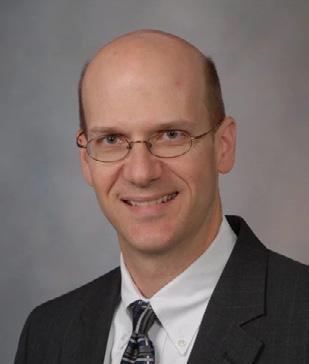
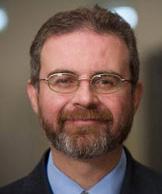
www.aapm.org | 25 AAPM Newsletter | September/October 2023 Volume 48, No. 5
UPDATE
ABR
Matthew Podgorsak, PhD ABR Trustee Roswell Park Cancer Institute
Kalpana Kanal, PhD ABR Trustee University of Washington
Robert Pooley, PhD ABR Trustee Mayo Clinic
Geoffrey Ibbott, PhD ABR Associate Executive Director
committee’s work. This includes participating in committee review calls throughout the item-writing cycle during which new questions are processed; providing final review and approval of the content for an exam or OLA question set as developed by a committee; and reviewing exam results. Each medical physics trustee is responsible for the content developed by their respective subspecialty’s Part 2 qualifying exam committee and Part 3 oral certifying exam committee. They also oversee the committees involved with writing physics content for exams administered to our medical colleagues. Finally, the Initial Certification Advisory Committee and the Continuing Certification Advisory Committee, comprising AAPM members who provide valuable input and feedback to the ABR, are chaired by Drs. Pooley and Kanal, respectively.
For disciplines that administer an oral exam (currently interventional radiology/diagnostic radiology, medical physics, and radiation oncology), the trustees are involved in selecting examiners and working with their AEDs to provide training before each exam administration. On occasion, trustees participate as examiners, although the main trustee responsibility during an oral exam administration is to remotely observe examiners to confirm that they are complying with their training and following the ABR’s guidelines.
Trustees attend several in-person meetings during the year. These include an annual meeting of each committee attended by the committee chair, exam developers, and
a subset of the committee members, where further content development and exam preparation take place. Trustees participate in the oral exams given by their disciplines twice each year. Under the ABR’s current model, one annual oral exam administration is a hybrid event for examiners, with approximately 50 on-site in Tucson and the remainder examining from remote locations. (Candidates continue to participate remotely in all ABR exams.) Twice per year, trustees participate in an in-person board meeting where they collaborate with ABR governors, executives, directors, and selected staff. The BOT is active between retreats via remote meetings that are called by the BOT chair to discuss issues that cannot wait until a formal retreat. Typically, two to five such meetings take place each year. Finally, trustees meet with the leaders of their specialty’s professional organizations to obtain feedback from stakeholders and discuss topics of mutual interest. For the medical physics trustees, this includes annual meetings with CAMPEP and AAPM leaders, typically held during the annual AAPM summer meeting. The AED meets with Society of Directors of Academic Medical Physics Programs (SDAMPP) leadership more frequently.
The ABR’s mission could not be accomplished without the contributions of its trustees, who provide countless volunteer hours on behalf of the public through oversight of the Initial Certification and Continuing Certification programs. ¢
26 | www.aapm.org AAPM Newsletter | September/October 2023 Volume 48, No. 5 ABR UPDATE , Cont.
ACR Accreditation & more: Info for Medical Physicists
UPDATES FROM ACR HQ
Technical Standards Available for Public Comment!!!
The public comment period for ACR’s Practice Parameters and Technical Standards — or Field Review, as ACR calls it — is underway. This year, all documents are available for review for a seven week period, instead of the previous process that included multiple Field Review cycles with a handful of documents in each. Key details:
• Field Review is August 21–October 6
• ACR members can access all documents and comment individually by clicking the “Review and Comment” button here.
• AAPM members are sent all of the ACR-AAPM collaborative documents by email, with instructions on how to submit your comments. AAPM membership comments are collated by AAPM leadership and submitted to ACR by AAPM staff on behalf of AAPM as an organization.
• This is your last chance to comment on these documents! Comments are organized by ACR staff in the Fall, calls are scheduled with the writing committees and ACR Council Steering Committee to discuss and resolve all comments in January and February, and then the documents are embargoed until given to ACR Council in preparation for the ACR Annual Meeting, where Council will deliberate and vote on the documents as Resolutions, i.e., ACR policy.
• ACR-AAPM Technical Standards for review this year are:
o Diagnostic Interpretation Displays (*NEW*)
o DXA
o IGRT
o MRI
o SBRT
NM & PET Accreditation changes effective 01/01/2024
PET: Passing range of Mean Bkgd SUV values will tighten slightly to 0.90 – 1.10 (currently 0.88 – 1.12).
NM: Definition of a small rectangular field camera will change to smallest dimension < 32 cm (current requirements state longest dimension < 32 cm). ¢
Dustin A. Gress, MS Senior Advisor for Medical Physics

ACR Quality and Safety
In each issue of this newsletter, I present information of particular importance or relevance for medical physicists. You may also check out the ACR’s accreditation support page for more accreditation information and QC forms. Thank You to all the other staff that keep ACR programs running and assist with creating the content in this column.
As part of the recent scope expansion of Image Wisely®, monthly educational exhibits presented by the Radiological Society of North America (RSNA) will include MR and contrast media safety content. The March exhibit featured education on safe MR imaging for patients with implanted devices. Access all of the RSNA educational exhibits provided by Image Wisely
www.aapm.org | 27 AAPM Newsletter | September/October 2023 Volume 48, No. 5
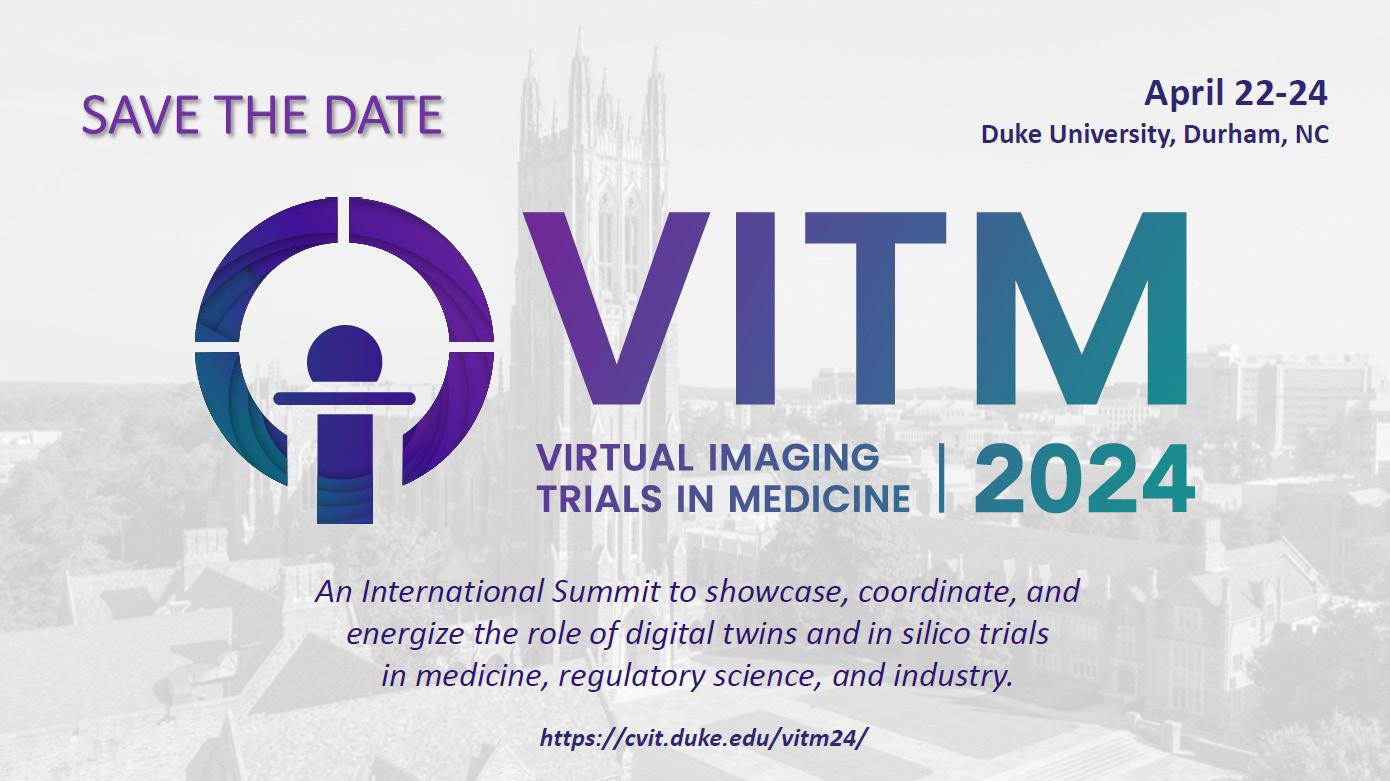

Virtual Imaging Trials in Medicine International Summit





VIRTUAL IMAGING TRIALS IN MEDICINE
TheCenter for Virtual Imaging Trials, under the direction of Ehsan Samei, PhD, is proud to present the first International Summit on Virtual Imaging Trials in Medicine. Hosted at Duke University, this summit will gather leading experts, researchers, and practitioners in medical imaging and therapy using in silico virtual trials and digital twins in medicine. The complexity and diversity of medical technologies and applications have continued to accelerate, outpacing our ability to optimize their design and use. This has become a significant challenge across the spectra of scientific inquiries, product designs, and clinical applications. The evaluation of new innovations would ideally be achieved through clinical trials. However, such trials are often not feasible or even definitive due to ethical limitations, expense, time-requirements, difficulty in accruing enough subjects, or the fundamental lack of ground truth. In silico or Virtual Trials (VT) provide an alternative approach to assess the impact of such innovations on patient care. They offer a new truth-based approach to conduct medical trials that can be made to be clinically relevant, timely, and accurate while reflecting the variabilities of human bodies and complexities of technologies, providing answers that would otherwise be impractical or unattainable. A VT consists of:
1. Realistic populations of computational patients spanning ages, sexes, and races.
2. Detailed models of clinical technologies or applications, and
3. Computational representations of the outcome assessment.
Envisioned as the first in a series, the objective of this Summit is to consolidate the latest developments, summarize the current status, and envision the future prospects of in silico virtual trials and digital twins in medicine. A two and a half-day event will include plenary speakers, proffered presentations, and perspectives from the industry, regulatory bodies, and funding agencies. The event is meant to serve as a forum to discuss methods, opportunities, challenges, limits, and future direction of virtual trials in medicine. Go and visit the website for more information! ¢
www.aapm.org | 29 AAPM Newsletter | September/October 2023 Volume 48, No. 5
Ehsan Samei, PhD Duke University Ehsan Abadi, PhD Duke University
Paul Segars, PhD Duke University Joseph Lo, PhD Duke University
Liesbeth Vancoillie, PhD Duke University


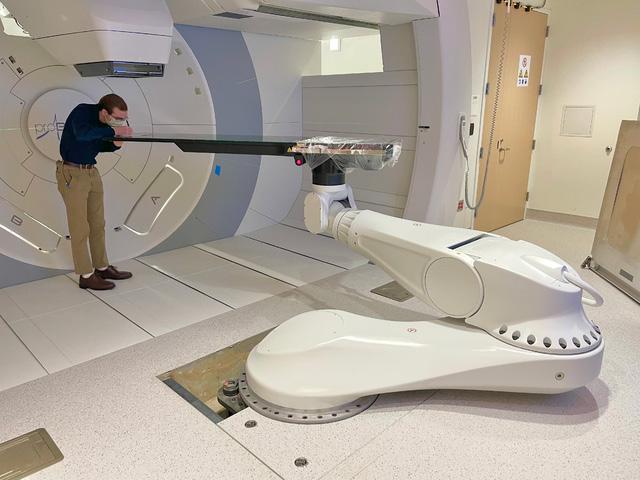



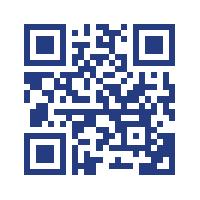
2024 SCAN THE QR CODE AND VISIT: for regularly updated information on all AAPM funding opportunities. gaf.aapm.org AMERICAN ASSOCIATION OF PHYSICISTS IN MEDICINE
Special Interest Feature: Professional Mentorship Working Group
THE
Jeremy Hoisak, PhD | UC San Diego, Chair, PMWG
 Robin Miller, MS | Northwest Medical Physics Center, Chair, PROFS
Robin Miller, MS | Northwest Medical Physics Center, Chair, PROFS
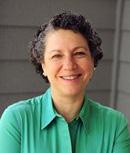
Report from the Professional Mentorship Working Group and Professional Services Committee
The 2023 Annual Meeting this past July in Houston, Texas marked nearly one year since the AAPM Mentorship Program launched as a new service for all AAPM members. The AAPM Mentorship Program is a free service that allows any AAPM member to participate as a mentor or mentee. This service is on-demand and mentees can request a mentoring match at any time from the pool of available mentors. Over 100 mentors and 100 mentees have signed up, and there are currently 67 mentoring matches active in the Program. For many participants, the Annual Meeting in Houston also marked the first face-to-face meeting after many months of virtual (but productive!) collaboration and helped to reinforce what are sure to be long-lasting and rewarding professional and personal relationships.
As we approach the Mentorship Program’s second year, we wanted to highlight some of the many mentorship success stories that have been shared by participants. These stories illustrate the many applications of mentorship and benefits for both participants and celebrate the achievements of AAPM members working together on shared
goals. We also hope these stories will inspire others to consider participating in the AAPM Mentorship Program either as a mentee or mentor. Any AAPM member at any career stage is welcome to join. Learn more about the AAPM Mentorship Program here
The AAPM Mentorship Program is a free service from the AAPM to match mentors with mentees to work together on individualized career goals. All AAPM members can participate as a mentor or mentee regardless of career stage!
• Matching is on-demand: mentees can browse and select from the pool of available mentors at any time.
• Mentors and mentees set their own goals, expectations, schedules, and meeting formats.
• Commitment is for up to one year but can be ended at any time by either party with no fault.
• Once a relationship has ended, participants are free to re-match or can pause participation.
For more information on how to volunteer as a mentor or participate as a mentee, please visit the AAPM Mentorship Program website, email us and follow us on social media @AAPM_PMWG.
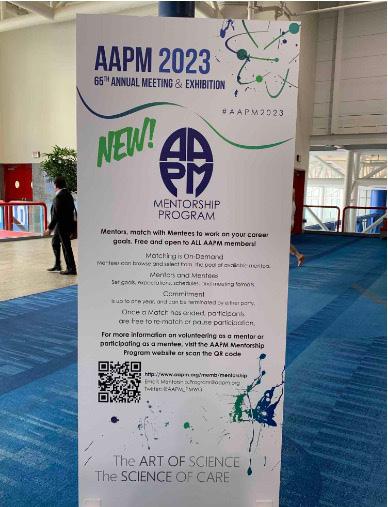
www.aapm.org | 31 AAPM Newsletter | September/October 2023 Volume 48, No. 5
AAPM MENTORSHIP PROGRAM: SUCCESS STORIES FROM OUR FIRST YEAR
THE AAPM MENTORSHIP PROGRAM: SUCCESS STORIES FROM OUR FIRST YEAR , Cont.
Mentorship Success Stories
“The Program was exactly what I needed, when I needed it.”
Emily Hansen, MS (Mentee) Physics Resident, Hackensack University Medical Center

What motivated you to participate in the AAPM Mentorship Program?
Prior to joining, I felt I didn’t really have a good support system, so I’ve done most things (i.e., college and grad school) on my own. However, in grad school I had this impression that everyone else in my class had a better understanding of how the training and career ‘process’ worked and seemed to have access to information that helped them move ahead. By the time I graduated I was feeling incredibly burnt out from doing it all by myself. I knew that I wanted to pursue a career in medical physics but I needed help to evaluate my options and find the right path for me.
How did mentorship help you to achieve your personal development goals?
My goal in joining the Mentorship Program was to figure out the next steps on my medical physics career path. I have a master’s degree in medical physics and was working as a physics assistant at California Protons in San Diego, and I was unsure if I should apply for a residency position now or consider applying for PhD
programs. I was fortunate to match with my mentor Jeremy who had a similar career trajectory and had faced the same questions. He helped me to identify a course of action, and with his help, I developed a residency match strategy, identified programs that would be a good fit, prepared my application materials, and prepped for interviews. I am happy to report that I matched into and have now started a residency position at a great institution!
What was the most rewarding aspect of your participation in the program?
I feel a lot more confident in my abilities and I really feel like I have been positioned to succeed in the clinic. Going into this process, I was thinking I would have to beg a residency program to take me, but with the help of my mentor Jeremy throughout the residency application process, I've realized that I really do have valuable medical physics skills and other applicable experience from grad school and prior employment. I also feel a much stronger sense of belonging to the medical physics community. The field itself seems a lot more approachable than it did last year and I now feel like I have the tools and information necessary to navigate the field of medical physics and carve out a place for myself and my career goals.
Can you provide advice for participants on how to make the most of mentorship?
Don’t be afraid to reach out to your mentor for advice/help if things aren’t going according to plan. They are happy to help or they wouldn’t have volunteered! If you are falling behind or feeling lost they can help offer
the resources, guidance and outside perspective to help you get back on track. It took me a long time to get over the email fear (am I being annoying/asking for too much?) but every communication from my mentor was so helpful and understanding and put my mind at ease.
“Be open and honest with your mentor; the more you give them, the more they can help.”
— Michael Lauria, PhD (Mentee) Physics Resident, UCLA

What motivated you to participate in the AAPM Mentorship Program?
Coming into residency, I had two goals outside of clinical training: submit a grant proposal, and get involved in AAPM. I joined the Mentorship Program to find someone with an outside perspective that could help me with these goals, along with navigating the job market and surviving residency. The Mentorship Program presents a database of available mentors and their short descriptions about their experience and motivation for volunteering in the Mentorship Program which is very helpful for identifying a mentor. One particular profile’s description assured me they were kind, excited, and dedicated to mentorship and so was my obvious first choice. I was soon matched to my new mentor, Robin.
32 | www.aapm.org AAPM Newsletter | September/October 2023 Volume 48, No. 5
THE AAPM MENTORSHIP PROGRAM: SUCCESS STORIES FROM OUR FIRST YEAR , Cont.
How did participation in the Mentorship Program help you to achieve your personal or professional development goals?
My mentor Robin and I have met every month this past year to talk about things going on in my life as well as hers. On my end, our early conversations surrounded how to step into residency and find ways to standout and improve clinical processes and workflows – advice which helped me take some initiative on several projects that have made my life as well as everyone else’s much easier. As we moved along the year, we branched out into monthly goal setting, advice on how to find the right clinic to start my career, how to build the best application for those clinics, and how to maximize my time during residency. My mentor always has incredible advice about leadership training and resources through AAPM that have introduced me to new people and lessons in leadership. My mentor Robin’s updates about working with a new team in a new clinic have been equally intriguing and informative as I may soon have to face the same challenges (and welcomed excitement). Hopefully for her I was a nice escape and a way to continue practicing mentorship skills.
How did mentorship help you to achieve your personal development goals?
These lessons about careers and leadership have been very rewarding, but even more rewarding has been developing a strong relationship with someone so impressive in our field. Our monthly meetings have been a wonderful relief from the work day to
both decompress and get excited about the road ahead. Meeting in person for the first time at AAPM was all hugs and laughter, and I know I have found a new friend through this program.
What advice do you have for participants on how to make the most of mentorship?
To make the most of the Mentorship Program, I would recommend mentees be open and honest about their lives, careers, limitations, and anxieties. The more you give your mentor, the more likely they are to offer the most impactful advice. I would also recommend setting goals with one another since in my experience, this forced me to stay on top of things in a very busy time. I highly recommend that both mentors and mentees take full advantage of the program. I’ve accomplished many of my goals this year, including my two major goals for residency, thanks to my mentor Robin’s advice and encouragement.
“My mentor has inspired so much confidence in myself.”
— Sarah Aubert (Mentee) Graduate Student,
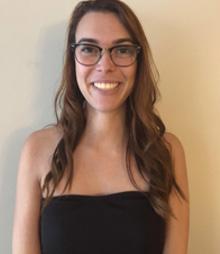
Toronto Metropolitan
What motivated you to participate in the AAPM Mentorship Program?
I chose to participate in the
University
AAPM Mentorship Program because I was looking to find a female mentor working in medical physics. I was keen on hearing about the experience of an established medical physicist and wanted to learn more about various career paths, career opportunities, leadership roles and workplace environments.
How did participation in the Mentorship Program help you to achieve your personal or professional development goals?
I went into the Mentorship Program hoping to gain some insight on how to identify good work environments, how to balance academia and extracurriculars and how to approach interviews. When I first joined, I was in the process of participating in the MedPhys Match. My mentor Heather was extremely helpful in offering advice on how to best prepare a CV, prepare for different types of interviews and was overall instrumental in making me feel supported during the process. I feel that my participation in the Mentorship Program, and the support and encouragement I received from my mentor really helped me to be successful in the match process and allowed me to move one step closer to my career goal of becoming a medical physicist.
What was the most rewarding aspect of your participation in the program?
One of the most rewarding aspects of participating in the Mentorship Program has been receiving an external perspective. Often as students and trainees we only receive feedback from our supervisors or direct peers, however as part of the Mentorship Program I was able to ask
www.aapm.org | 33 AAPM Newsletter | September/October 2023 Volume 48, No. 5
THE AAPM MENTORSHIP PROGRAM: SUCCESS STORIES FROM OUR FIRST YEAR , Cont.
for advice from someone outside of my institutional circle which was key in helping me to put decisions into perspective. For me, the greatest part of being part of the Mentorship Program has been gaining a role model in my mentor, Heather, and learning from someone who is a remarkable physicist, leader and human. I have learned so much from her and I hope to continue to do so as I move on to the next stage of my academic career. My mentor has inspired so much confidence in myself.
What advice do you have for participants on how to make the most of mentorship?
I have found that really being yourself while talking with your mentor is beneficial. Sometimes, when enrolled in formal mentorship programs it’s easy to present a version of ourselves that we want others to see. I have gained a lot by being myself when talking with my mentor Heather. Additionally, I think it’s important to choose a mentor that you can relate to and that can help you reach the goals you set for yourself when joining the program.
“Mentoring keeps me accountable: I have to follow my own advice!”
— Heather Warkentin, MS (Mentor) Medical Physicist, Cross Cancer Institute
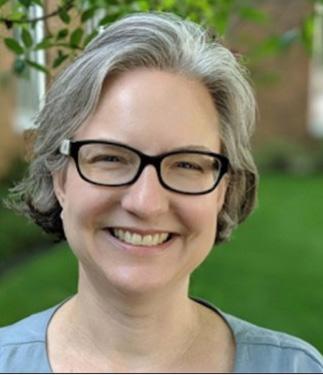
What motivated you to participate in the AAPM Mentorship Program?
I have had good experiences with mentorship programs in the past so I signed up immediately when I heard about the AAPM Mentorship Program. I have been a mentor with the McMaster University Innovation and Society Mentoring Program and with the COMP Ada Lovelace Day Mentorship Program. In both of those programs I had a really great experience, in particular working with the Medical Physics graduate students as they are making important decisions about the career path they want to take. I want to make sure early career medical physicists feel supported and welcomed to our profession.
How did participation in the Mentorship Program help you to achieve your personal or professional development goals?
Mentoring keeps me accountable: I have to follow my own advice!
My mentee Sarah is very active in outreach and volunteering with our professional associations. Seeing how much she has accomplished has inspired me to say yes to more opportunities. Being a mentor also
helped me to realize that I could use a mentor myself, even after almost 25 years in the clinic. Finding new mentors at every stage of our careers can help us to identify new professional avenues to explore, or better prepare us to tackle new challenges.
What was the most rewarding aspect of your participation in the program?
Definitely it was getting to know my mentee Sarah. I don’t think I would have met her otherwise, as we are serving on different committees with AAPM and COMP and we are attending different conferences. Watching my mentee achieve her goals has brought me a lot of joy, even though it had nothing to do with me and everything to do with her own excellence.
What advice do you have for participants on how to make the most of mentorship?
Take the time to get to know each other at the first meeting and allow time for some casual conversation at every meeting. Don’t dive right into giving/receiving advice. The more you know about the context of your mentee’s life and what is truly important to them, the better you can advise them. My mentee Sarah always came to our meetings prepared with a few questions. This really helped to focus our conversations. Sometimes I felt like I wasn’t the right person to be helping her with something, but in those cases I could point her towards a different person or resource that would have the information she needed. Mentors shouldn’t feel like they need to have all the answers, just be willing to listen and share their experience and network.
34 | www.aapm.org AAPM Newsletter | September/October 2023 Volume 48, No. 5
THE AAPM MENTORSHIP PROGRAM: SUCCESS STORIES FROM OUR FIRST YEAR , Cont.
“The AAPM Mentorship Program allowed me to choose a mentor that fit my values and career aspirations.”
— Rachel Trevillian, MS (Mentee) Physics Resident, MD Anderson Cooper
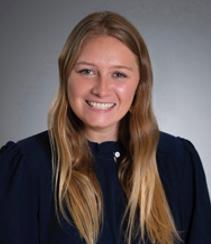
What motivated you to participate in the AAPM Mentorship Program?
As a resident who is still early in their career, I thought that the AAPM Mentorship Program would allow me to have a mentor to assist me in navigating through the challenges of residency, getting involved in AAPM, and how to prepare to become a certified physicist. I have always loved learning about the life and career pathways of others so the Mentorship Program gave an outlet to do this as well as seek advice!
How did participation in the Mentorship Program help you to achieve your personal or professional development goals?
My mentor Elizabeth pushed and motivated me professionally by providing advice for the board exams, giving me practice part 3 exams to make me more comfortable with them, as well as offering resources that she found helpful! My personal goals initially were to get more involved in AAPM and my mentor helped encourage me as well as keep me accountable by setting goals. Each time we met we would discuss goals and updates going on in our lives, which made our discourse both professional and personal!
What was the most rewarding aspect of your participation in the program?
The most rewarding aspect is the relationship I have developed with my mentor Elizabeth and will hopefully continue to develop over time! She not only has given me great advice for my future in medical physics but has also tried to help me as I begin to look for a job after residency.
What advice do you have for participants on how to make the most of mentorship?
You will get out as much as you put into the program! I would recommend you choose a mentor that fits your values and career aspirations so that you are both benefiting from the experience.
“No matter where you are in your career, I think giving and receiving mentorship can be beneficial.”
different relationship than mentoring someone in medical physics.
How did participation in the Mentorship Program help you to achieve your personal or professional development goals?
One tangible way being a mentor helped me is that I created some practice ABR Part 3-style questions for my mentee Rachel that we go through each month, which has been a great way for me to keep up with my medical physics knowledge. Mentoring has also made me more aware of my professional strengths/ weaknesses when my mentee has asked me about my experiences.
What was the most rewarding aspect of your participation in the program?
—
Elizabeth Hilliard,
MS (Mentor) Medical Physicist, SUNY Upstate Medical University
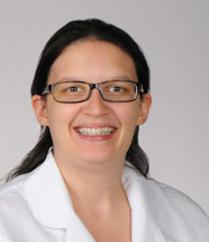
What motivated you to participate in the AAPM Mentorship Program?
I can point to specific people throughout my education and professional life who helped me get to where I am today, and I want to be able to do that for someone else. My clinic doesn't have a physics residency program, so although I do get to mentor radiation oncology residents and radiation therapy students, it's a
I joined the Mentorship Program in September 2022 when my mentee Rachel was just two months into her residency. Now, in August 2023, she is the senior resident and although I have only played a small part in it, seeing how much she has grown in confidence (and knowledge!) is very rewarding. We also got to meet in person for the first time at this year's AAPM annual meeting!
What advice do you have for participants on how to make the most of mentorship?
Set expectations in the beginning for both the mentor and the mentee! The mentorship program website has resources on what sort of goals are typical for a mentoring relationship, so I recommend using those. Making sure that your goals are aligned at the beginning will go a long way in making the most of mentorship.
www.aapm.org | 35 AAPM Newsletter | September/October 2023 Volume 48, No. 5
THE AAPM MENTORSHIP PROGRAM: SUCCESS STORIES FROM OUR FIRST YEAR , Cont.
Is there anything else that you want to share about your experience in the AAPM Mentorship Program?
No matter where you are in your career, I think giving and receiving mentorship can be beneficial. I was a little nervous as a mentor at first because I had only finished residency two years prior, but being recently
graduated meant I had recent perspectives and I am still able to help my mentee Rachel see that there is a light at the end of the education/ training tunnel.
Learn more about the AAPM Mentorship Program here. You can email us at Mentorship.Program@ aapm.org
and follow us on social media

@AAPM_PMWG.
Webinar #35: Debate: AI-based Autosegmentation: Slow Adoption vs Pivot Opportunities to Increase Capacity for Adaptive
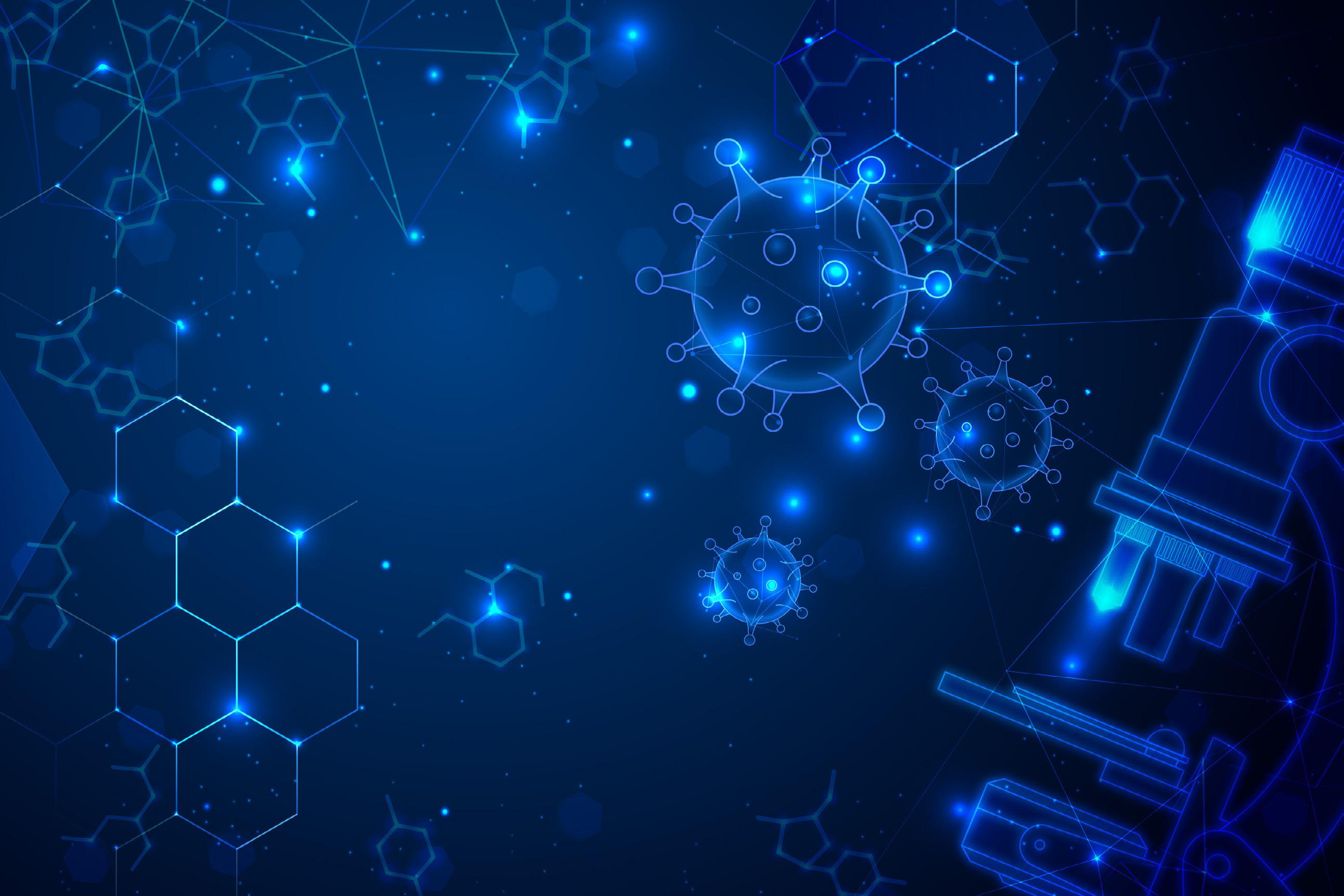
36 | www.aapm.org AAPM Newsletter | September/October 2023 Volume 48, No. 5
¢ UPCOMING WEBINARS OCT 26 12:00 PM|ET
AAPM Webinar Series on Advances in Medical Physics
Register for these events at https://aapm.me/webinars OCT 12 12:00 PM|ET How Recognition Creates Belonging SEPT 5 12:00 PM|ET AAPM Webinar Series on A Medical Physicist Guide to Sexual and Gender Minority Health & Well-Being Part 2
Radiotherapy?
Special Interest Feature: Professional Mentorship Working Group
PREPARING FOR A FIRST MENTORSHIP MEETING
Elizabeth Hilliard, PhD | Member, Professional Mentorship Working Group
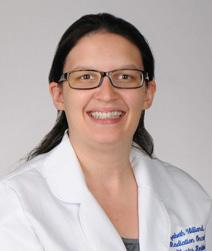
Adapted from the AAPM Mentorship Toolkit.
Thefollowing is a list of suggested tasks to complete and questions to consider prior to a first meeting between mentor and mentee, as well as strategies to employ during the first meeting.
1. Take time to get to know each other.
• Obtain a copy of each other’s CVs prior to the first meeting.
• What other information could you share to get to know each other better?
• What points of connection have you discovered in your conversation? What else do you want to learn about each other?
2. Share your mentoring experiences.
• In advance of the meeting, think about your personal history with mentorship, your current mentors/ mentees and what you work on with them, and try to identify any gaps or needs in your ‘mentoring network’.
• Share your previous mentoring experiences with each other.
• What did you like about those experiences that you hope to repeat in this relationship? What problems do you want to avoid?
• Was there anything lacking from the previous mentoring experiences that you would like to see in the current mentoring relationship?
3. Share your personal development goals.
• Describe your career vision, hopes and dreams, and articulate broad personal development goals and the reasons why they are important.
• Why do you want to engage in mentorship to achieve these goals?
4. Determine relationship needs and expectations.
• Ask your mentor/mentee what they expect out of the relationship.
• Discuss communications modes, frequency and availability.
• What would be a logical time/ outcome to indicate an end to the mentoring relationship?
5. Candidly share your personal assumptions and limitations.
• What assumptions do you hold about each other?
• What are you each willing and capable of contributing?
• What limitations do you each bring to the relationship?
6. Discuss your mentoring and learning styles
• Talk about your personal mentoring and learning styles.
• How might each other’s styles affect the learning that goes on in the mentoring relationship?
• Is there a natural mentorship style that suits the goals of the mentoring relationship?
First Mentorship Meeting: A Checklist
Mentors and mentees should aim to discuss and agree on:
a) scheduling of meetings,
b) frequency and mode(s) of communications c) responsibility for rescheduling missed meetings, d) confidentiality, e) “off-limits” topics, f) giving and receiving feedback, and g) mentee personal/career development goals.
Below is a checklist to help get the most out of the first meeting for mentor and mentee.
1. Get to Know Each Other
Share information about your professional and personal life.
Learn something new about your mentee/mentor.
2. Establish Expectations
When and where will we meet?
How will we schedule meetings?
How will we communicate between meetings?
Will there be any fixed agenda items to be discussed at every meeting?
How will we provide feedback?
How will we measure success?
How will we close the mentoring relationship?
3. Develop a Personal Development Plan
Identify one or more personal or professional goals for the mentoring relationship.
Determine specific objectives to meet towards each goal.
Identify potential barriers to meeting those objectives.
Set estimated dates for completion of each objective.
4. Confirm Next Steps
List action items for the next meeting.
Schedule date and time of future meetings. ¢
www.aapm.org | 37 AAPM Newsletter | September/October 2023 Volume 48, No. 5
CONNECTING medical physicists with the finest JOBS


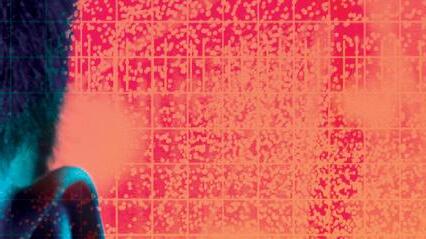
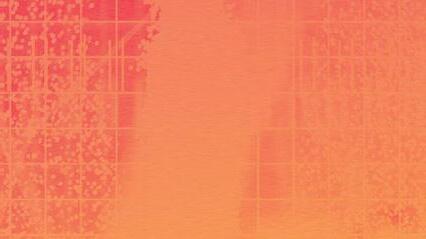
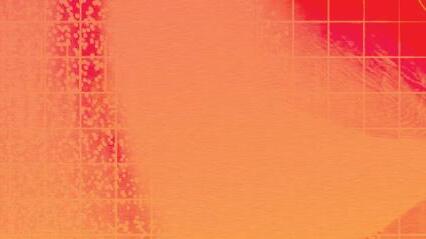

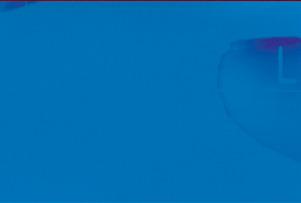

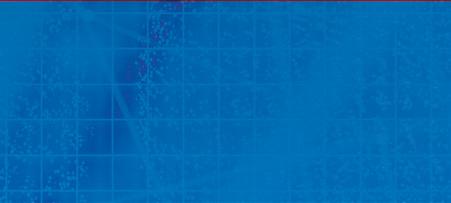







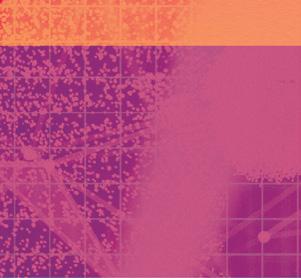
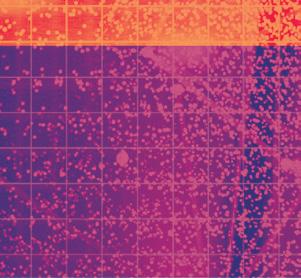

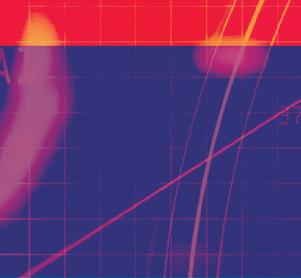


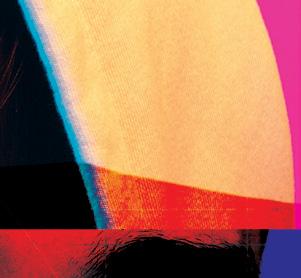





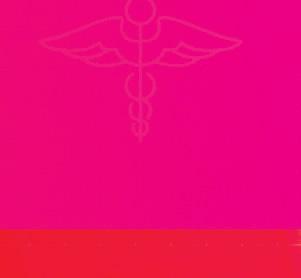

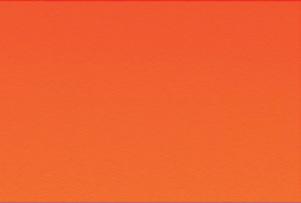




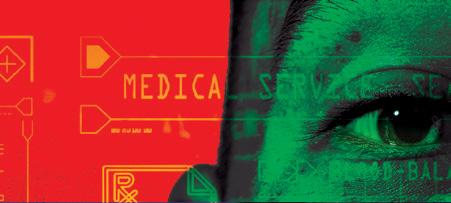







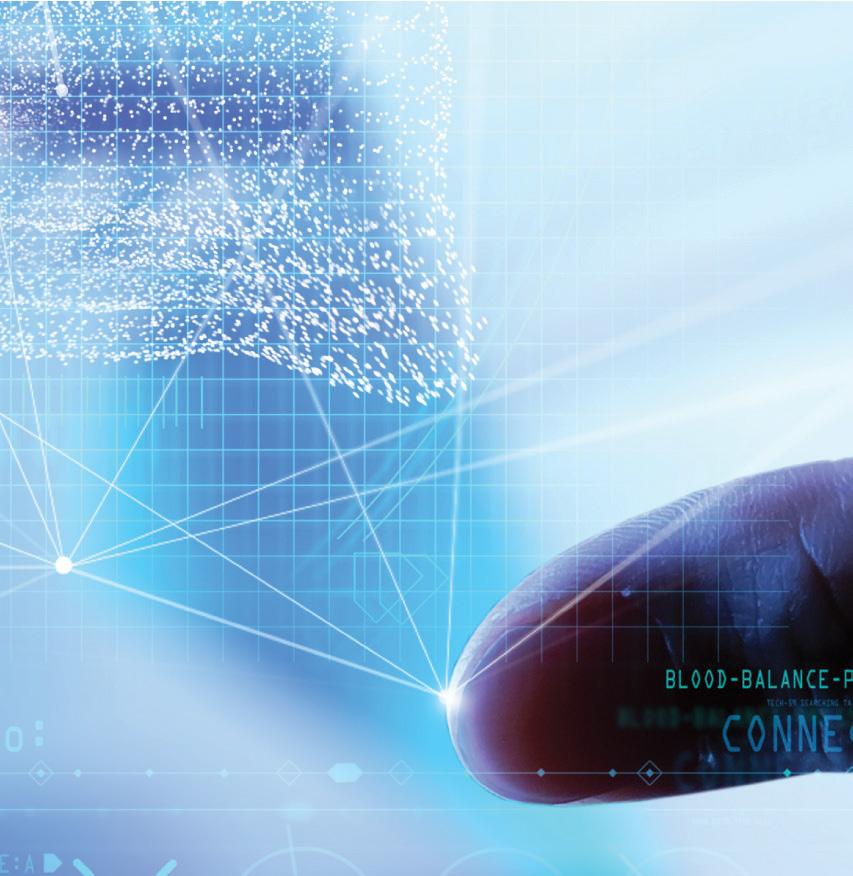
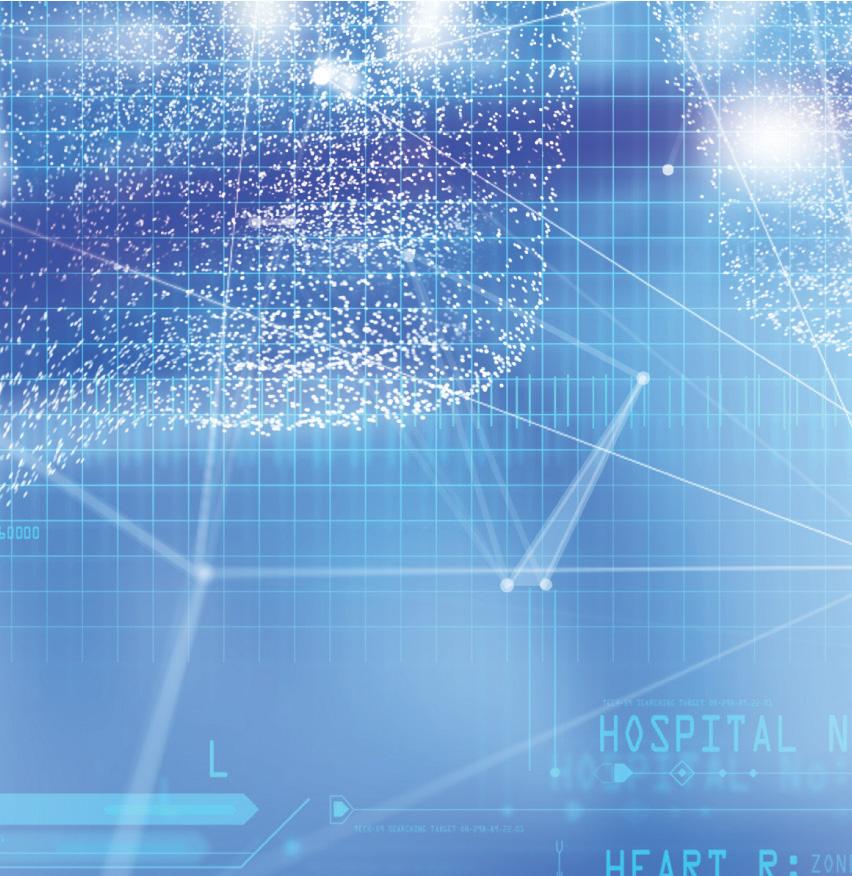

AAPM CAREER SERVICES
Find your future at aapm.org/careers
One Graduate Program's Medical Physics Outreach Journey
 EDUCATION COUNCIL REPORT
EDUCATION COUNCIL REPORT
Each of us has a story about how we entered the field of Medical Physics. Some may have been fortunate to be enrolled at an academic institution with a medical physics graduate program, others may have learned about medical physics from a friend, family member, or trusted teacher or mentor, and others may have been introduced to the field through happenstance. As an instructor, mentor, and, in my current role, as AAPM Education Council chair, I have been rewarded with hearing about many of these journeys, as well as some incredible and awe-inspiring work from our students and trainees in their efforts to open the door to the field to the next generation of medical physicists through outreach. In this edition of the AAPM Newsletter, we will learn about outreach efforts led by the graduate students at the University of Chicago as Hadley DeBrosse and Gia Jadick take us through their journey to medical physics outreach.
— Joann Prisciandaro, PhD AAPM Education Council Chair
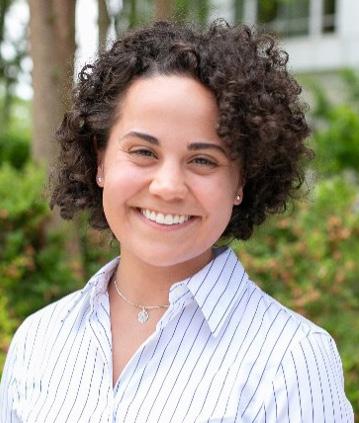
Overthe past year, our medical physics graduate program at the University of Chicago has developed a thriving outreach program. The kickstart we needed came in the form of serendipitous connections, supportive university infrastructure, and work of previous medical physics outreach enthusiasts. It is our hope that this outline of our outreach journey might help fellow medical physicists expand their outreach programs with intention.
For years, our program strived to build such an outreach initiative, but struggled to find a path forward. The difficulty was not for lack of motivation — of their own volition, our graduate students frequently mentored, volunteered, and tutored in underserved communities. Once a year, our students and faculty joined together to participate in the University of Chicago outreach event “Physics with a Bang!”, which invited community members of all ages to explore interactive scientific demonstrations scattered around campus. Though we brought our share of demos, we found our activities were limited compared with the trove of physics demos neighboring our table. Next to us, children rode hovercrafts, toyed with homemade slime, and played with a colorful Van de Graff generator.
We realized that many introductory concepts in mechanics and E&M naturally lend themselves to interactive, physical demonstrations — great for engaging kids and parents alike. So much of a medical physicist's work deals with the invisible: photons too energetic for the eye, mechanical waves at frequencies beyond the ear, magnetic fields undetectable by the senses, and so on. We asked ourselves: what is the most engaging way to teach these concepts to the public?
Due to the pandemic, we placed our outreach activities on pause for a few years and reflected on this essential question. Perhaps this caused a
www.aapm.org | 39 AAPM Newsletter | September/October 2023 Volume 48, No. 5
Hadley DeBrosse University of Chicago
Gia Jadick University of Chicago
buildup of outreach fervor. In 2022, the science divisions at the University of Chicago joined forces to launch the inaugural South Side Science Festival (S3F). Lacking resources but full of enthusiasm, our graduate program brainstormed ideas for demos we could scrape together with what few materials we had lying around our student lounge. Our goal was to design activities both engaging and educational for community members of all ages. We supplemented our physical materials with hybrid computational components to maximize their interactivity [1]. For example: We revitalized our existing “Flashlight X-ray Box” and augmented it with graphics of tomographic reconstruction, where festival-goers clicked around a virtual gantry to adjust angular coverage and observe resulting changes in CT images. We designed a new demo “Waves on a String” from a guitar scavenged from our student lounge to teach how MRI forms images with 2D plane waves, just as musical chords are formed with 1D sound waves. Another student used code to colorfully illustrate how machine learning is used to segment internal anatomy. Clinical faculty brought a portable ultrasound for live Doppler blood vessel imaging and scavenger hunting in a DIY phantom, and nuclear medicine specialists brought a Geiger counter and a test source to demonstrate radiation and shielding. Radiologists brought an interactive anatomical model to demonstrate a spinal procedure. The day was a hit! We were inspired by the engagement our booth garnered and filled with ideas to
expand our impact. Now, what next?
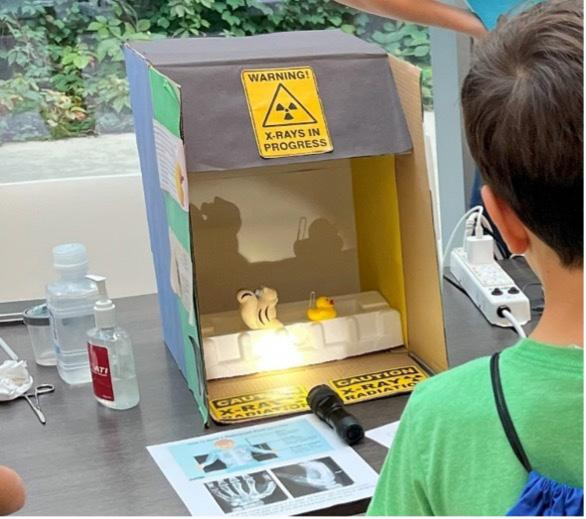

Our Diversity & Outreach (D&O) committee co-director, Kenneth Bader, PhD, happened to meet leaders of the Outreach & Education branch of the University of Chicago Comprehensive Cancer Center (UCCCC). The UCCCC described a previous experience connecting the cancer biology graduate program with Chicago Public Schools (CPS), and our advisor inquired about the possibility of facilitating a similar connection with the medical physics program. We did not anticipate the magnitude of their enthusiasm — their email reply:
“WE CAN BRING THE SPARK!”
and indeed they did! The UCCCC possessed dedicated resources for this sort of outreach and was actively searching for students to get involved. In January 2023, after months of preparation, the UCCCC helped our program host 35 high school physics teachers at the University of Chicago for a professional learning day focusing on medical physics. Five graduate students gave research talks on topics from basic particle interactions within the human body to novel imaging methods and cancer treatments. We guided the teachers around campus, giving tours of our laboratories and chatting about physics education and outreach. The day was invaluable in connecting us with teachers searching for scientists to bring into their classroom.
40 | www.aapm.org AAPM Newsletter | September/October 2023 Volume 48, No. 5
COUNCIL REPORT , Cont.
EDUCATION
Activities at the S3F: Gia Jadick demonstrating “Waves on a String” (left); “Flashlight X-ray Box” (right)
This event sparked two new avenues for outreach. We met a teacher from Tilden High School who was seeking science outreach groups for their “STEM Night” science fair. This was our first “away” event, toting our new arsenal of demos. We realized how smoothly these events could go once we had the demos in place, but we felt limited since we were unable to bring borrowed equipment.
A second teacher from Lindblom Math and Science Academy reached out, inviting us to design an interactive “choose your own adventure” lesson plan. Our graduate students created simulated clinical case studies comprising a patient file with a description of symptoms and options for imaging modalities to gain diagnostic insight. On the day of the lesson, our graduate students marched into the classroom sporting white coats and scrubs, playing the roles of chief physicists and radiation safety officers. High schoolers first familiarized themselves with the different
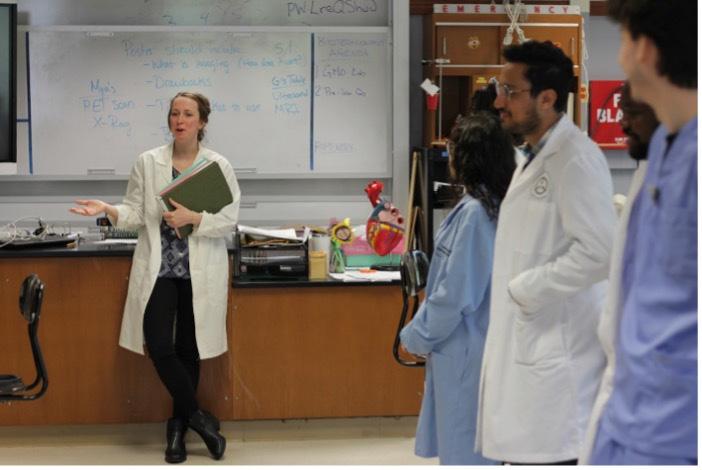
imaging modalities and then tackled the case studies, deciding which imaging modality to use and why. When the students “ordered” an image, we provided it so they could discuss a diagnosis; when they gave the patient an unnecessary scan, we guided them towards the correct conclusion. The students took their clinical duties seriously, becoming enraptured in the different scenarios and applying their new knowledge of imaging. We wrapped up the class with a short presentation about medical physics careers and summer research opportunities, optimistic that the students would keep us in mind as they begin college.

With this outreach momentum, our D&O committee faculty director, Emily Marshall, PhD, suggested a funding opportunity for streamlining our demo preparation pipeline. As we put together the grant application, we came across valuable frameworks in medical physics literature
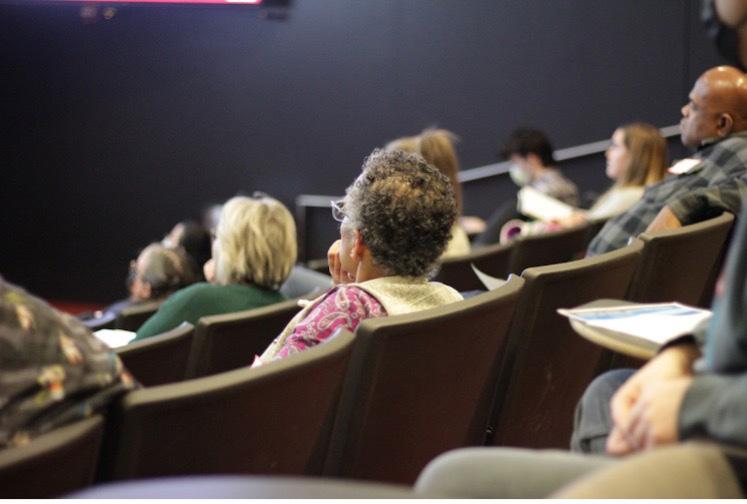

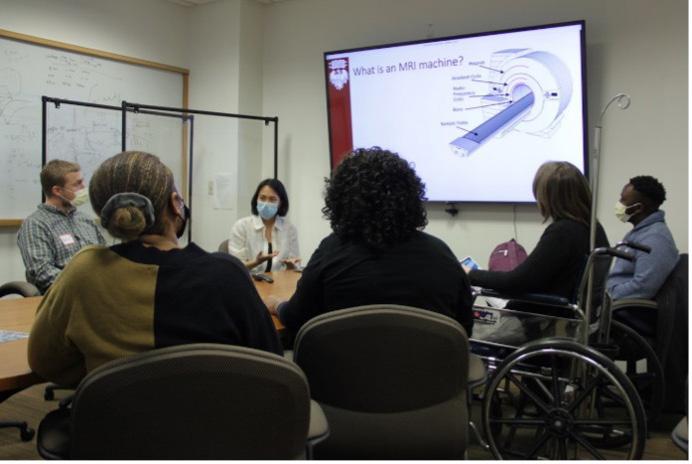
www.aapm.org | 41 AAPM Newsletter | September/October 2023 Volume 48, No. 5 EDUCATION COUNCIL REPORT , Cont.
“Choose your own adventure” interactive lesson plan at Lindblom high school: Hadley DeBrosse introducing the clinical tasks (left); discussing images and possible diagnoses (right)
Chicago Public Schools professional learning day lab tours: Mira Liu explaining MRI (left); CPS teachers examining ultrasound bubbles in a water tank at the Bader Lab (right).
CPS teachers listening to graduate student talks during the professional learning day.
that guided our proposed demo design and methods of quantifying results [2-5]. Our proposal was funded with matching support from the University of Chicago graduate program in medical physics (GPMP). Currently, we are designing outreach demos with inspiration from prior work and are purchasing the materials to create them. Additionally, the UCCCC generously funded a portable ultrasound dedicated to medical physics outreach, jointly owned by the UCCCC and GPMP. This growth also coincides with the expansion of our D&O committee leadership, with new student roles leading the charge in direct recruitment via high school classroom visits.
Reflecting on our experience, we passed through distinct phases that brought us to our current state of a thriving
Acknowledgements
We thank Megan Mekinda and Basia Galinski of the UCCCC for their tireless efforts organizing outreach events with CPS and for funding the purchase of a portable ultrasound; Joe O’Hara and other UCCCC EYES (Educators and Youth Enjoy Science) program teachers for organizing the Lindblom High School medical physics research lesson; Violeta Toma for inviting us to STEM Night at Tilden High School; the Biological Sciences Division Office of Diversity & Inclusion and the GPMP for funding our small grants proposal; Sam Armato, Ken Bader, and Emily Marshall for their invaluable advice and mentoring; and the many GPMP students who never fail to volunteer and contribute to our medical physics outreach vision.
medical physics outreach program. For those who are seeking a similar expansion, we recommend (1) forming a committee with students and faculty who are excited to be involved, (2) participating in existing opportunities, (3) connecting with collaborators who can help create new opportunities, and (4) securing funding for the creation of streamlined and engaging activities. The first year or two may be challenging and busy, but we believe that these connections, interactive activities, and demonstrations are worth the effort. We encourage all that are able to consider a similar expansion of their outreach programming; it is an excellent leadership and mentoring opportunity for graduate students, and it may be critical to maintain the health and diversity of our field’s membership. ¢
References
1. G. Jadick and M. Liu, UChicago Medical Physics OutreachComputational Demos, https://github. com/gjadick/uchicago-medphys-outreach, Accessed: 202307-25.
2. L. Buckley, “Su-f-e-08: Medical physics as a teaching tool for high school science curriculum,” Medical Physics, vol. 43, no. 6 Part 5, pp. 3354–3354, 2016.
3. J. M. Fagerstrom, W. Gao, and G. E. Robertson, “A hands-on introduction to medical physics and radiation therapy for middle school students,” Journal of Applied Clinical Medical Physics, vol. 20, no. 4, pp. 148–153, 2019.
4. M. van Zyl, E. M. Haynes, D. Batchelar, and J. M. Jakobi, “Examining gender diversity growth as a model for inclusion of all underrepresented persons in medical physics,” Medical Physics, vol. 47, no. 12, pp. 5976–5985, 2020.
5. A. P. Santoso, S. Jupitz, and C. Lin, “A framework for developing community-focused medical physics outreach programs,” Journal of Applied Clinical Medical Physics, vol. 22, no. 10, pp. 305–314, 202.
42 | www.aapm.org AAPM Newsletter | September/October 2023 Volume 48, No. 5
REPORT , Cont.
EDUCATION COUNCIL
Debunking Myths in the MedPhys Match: Collective Perspectives & Experiences from 2023 Candidates
MEDPHYS MATCH 2023 SPECIAL REPORT
Introduction
Launched in 2014, the Medical Physics Matching Program, namely the MedPhys Match, [1] was established to deliver a more fair, equitable, and transparent residency application process. Residency training is now a critical bottleneck toward American Board of Radiology (ABR) certification, making the Match process an important step for aspiring clinical medical physicists.
The Match process is competitive. This year, 61% of applicants successfully matched with an accredited medical physics residency program. [2] This competition and uncertainty, understandably, can breed moments of anxiety. Many prospective applicants seek tips and tricks to enhance their own applications to maximize their chance of matching. While advice on how to improve prospective Match prospects is often informally shared between past and present applicants and like-minded peers, colleagues, and friends, data-driven guidance from a trainee’s perspective is scarce. To address this, an independent student-led initiative was launched in March 2023, supported by the members of the AAPM Students and Trainees Subcommittee (STSC) and the Canadian Organization of Medical Physicists (COMP). This initiative involved distributing a questionnaire among the MedPhys Match 2023 participants, aiming to survey collective experiences and perspectives as an attempt to demystify both real and perceived factors influencing Match success.
This report seeks to investigate commonly suggested Match-influencing factors providing data-driven advice to prospective candidates. This report also offers an informal update on previous, comprehensive published Match experiences in the post-pandemic environment. [3]
Methods & Survey
The MedPhys 2023 Post-Match Questionnaire, comprising 47 items, was designed to capture data on candidate demographics, application materials, interviewing experiences, and Match outcomes, based on the factors commonly discussed among Match 2023 participants. [4] This survey also covered Match resource usage, applicant perceptions on various factors, and suggestions and advice to enhance future Match experiences. The questionnaire was distributed to MedPhys Match 2023 participants through AAPM and COMP student and trainee communications, and within various medical physics online communities and social media platforms on April 11, 2023. Responses were collected until April 28, 2023, at which time the form was closed for analysis.
Data preparation for analysis involved reviewing all the responses and cleaning the data to remove any nonsensical or incorrectly formatted responses. Free text responses underwent text coding to identify common response themes and count occurrences for more quantitative analysis. Data were stratified based on Match results (matched or unmatched) and visualized using histograms or bar charts. The significance of the influence of
Haley Patrick, PhD McGill University, Resident at BC Cancer Vancouver
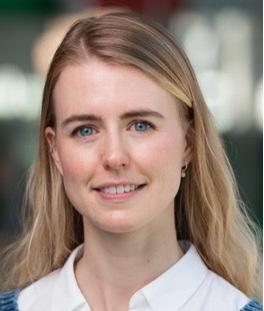

Sarah Morris, PhD University of British Columbia, Resident at NYU Langone Health
Huiming Dong, PhD University of California Los Angeles, Resident at UCLA

Claire Park, PhD Western University, Resident at Harvard Medical School

www.aapm.org | 43 AAPM Newsletter | September/October 2023 Volume 48, No. 5
any given factor on the Match result was determined using Chi-square tests for categorical data and Mann-Whitney U tests for ordinal data. Statistical significance was defined as p < 0.05, and a trend as p < 0.10.
Response Rates
Of the 313 eligible candidates who registered for the 2023 Match, 95 completed the questionnaire. This data captured 76 matched candidates (52.0% response rate) and 19 unmatched candidates (20.2% response rate) compared with the MedPhys Match 2023 statistics. [2] Although unsurprising, as candidates with a more positive experience may be more likely and open to share, the lower response rate among unmatched candidates limits our ability to make definitive conclusions regarding this group.
Effect of Commonly Suggested Factors
Table 1 presents candidates’ perceptions of several demographic and commonly discussed Match-influencing factors, along with their observed impact among survey
participants. No factor was found to significantly affect Match likelihood, including degree level (PhD vs. MSc) and ABR status. Notably, gender was perceived as the least influencing factor; however, in our sample, femaleidentifying candidates matched at higher rates on average than male-identifying candidates. Additionally, international candidates with an existing US or Canadian Visa had a similar Match rate to domestic candidates, although this result fails to reflect the restricted number of programs international candidates are eligible for based on the need for Visa support. Career path indecisiveness may also deter programs, as we observed candidates applying to both Diagnostic Imaging and Therapeutic Physics streams had lower Match rates compared to singlestream candidates.
Effect of Application Package
Our data revealed that the number of interview invitations a candidate receives, relative to the number of applications submitted (referred to as their interview invitation rate), was the most influential factor in matching
Students unregistered for ABR and those who had passed ABR Part 1 match rates were 77.3% and 82.8%, respectively.
Match rates were 82.0% for American residents/ citizens, 83.3% for Canadian residents/citizens, and 76.9% for international citizens with existing US/Canadian Visas. The number of international respondents without a Visa was too small to determine a reliable match rate.
Candidates applying to both specialties had a lower match rate (55.6%), than those applying to just one.
more negative perceptions among unmatched candidates.
44 | www.aapm.org AAPM Newsletter | September/October 2023 Volume 48, No. 5 MEDPHYS MATCH 2023 SPECIAL REPORT , Cont.
Potential Influencing Factor Believed to be a negative influence (%) Believed to be a positive influence (%) P-value of observed influence Comment Degree Level 26.9% 59.1% 0.306 MSc and PhD match rates were 74.3% and 83.0%, respectively. ABR Status 10.9% 38.0% 0.672
Citizenship 20.4% 33.3% 0.218
Gender or Sexual Identity 5.5% 4.4% 0.064 Male-
female-identifying match rates were
88.4%,
Specialization 13.0% 52.2% 0.185
Racial or ethnic identity* 8.8% 5.5% –Significantly
Institution of Study* 5.4% 53.3% – –
and
73.1% and
respectively.
Table 1: Candidate perceptions towards several commonly suggested Match-influencing factors and the significance of their influence as observed in the MedPhys Match 2023 Post-Survey responses.
*Information on racial or ethnic identity and institution was not collected to preserve respondent anonymity.
success (Fig 1a). The median matched candidate was invited to interview at 65% of the programs they applied to, while the median unmatched candidate only managed an interview rate of 18%. This underscores the importance of crafting a compelling application package that captivates the attention and interest of programs, as a key factor in Match success. The personal statement, as a critical component of a candidate’s application materials, revealed important insights about the candidate. Regardless of the Match outcome, the content of the personal statements bore many similarities across all candidates (Fig 1b). However, matched candidates were twice as likely to disclose their own motivations for pursuing a career in medical physics and less likely to elaborate on unique aspects of their CV, compared to unmatched candidates (Fig 1b).
Respondents were further asked to suggest additional factors influencing Match success. The top four most frequently mentioned elements pertained to their CV
or References (Table 2). Candidates deemed clinical, research, and volunteer experience as important factors, with 20% of matched applicants specifically attributing their clinical experiences as a reason they matched. Interestingly, while research experience and the number of publications are often an area for discussion and of concern for prospective applicants, our findings revealed that the average matched applicant had fewer papers than the average unmatched applicant (Fig 1c).

Advice for Future Applicants
Based on the data collected, demographic factors, such as degree level (PhD and MSc) and publication records may hold less sway in Match success than candidates often perceive. Future candidates should concentrate on crafting a compelling application package by engaging in clinical, research, and volunteer experiences, and seeking collaborators and opportunities that yield strong references. Moreover, consider seeking feedback and
www.aapm.org | 45 AAPM Newsletter | September/October 2023 Volume 48, No. 5 MEDPHYS MATCH 2023 SPECIAL REPORT , Cont.
Figure 1: Responses to a selection of key survey questions, stratified by Match outcome: (a) Interview invitation rate; (b) Inclusion of common personal statement components; (c) Number of peer-reviewed publications at application time; (d) Common Match information sources usage.
guidance from mentors, such as participating in the AAPM Mentorship Program, to gain insights and constructive feedback on your application materials. While these findings reveal candidate’s perspectives, we advocate for a follow-up survey specifically for program directors and executive committees to determine what they consider most important when reviewing applications. Inferences based on the present candidate surveys might be biased by assumptions about program directors’ preferences.
We also encourage future candidates to research residency programs and take advantage of various available resources and online communities surrounding the Match process, as was common among successfully matched applicants from the Match 2023 applicants (Fig 1d). An excellent starting point for gathering effective information for Match 2024 applicants is participating in the AAPM STSC On-Site or Virtual Residency Fairs and Resident Connect sessions. These events, hosted annually by STSC, provide an opportunity for prospective applicants to meet program directors, representatives, and current residents to learn about the specifics of residency programs.
While there is no definitive “recipe” for Match success, we would like to share the most common pieces of advice from the MedPhys Match 2023 candidates to pass on to future applicants:
1) Engage in self-reflection to determine what you want out of a residency. This clarity will help guide you in identifying and applying to the programs that align with your career and professional goals.
2) Be intentional and authentic in crafting your application and ranking process. Focus on programs that resonate
with your own goals and where you envision yourself thriving.
3) Capitalize on opportunities to gain clinical experiences and build a robust network during your training. Don’t hesitate to reach out to programs, current and past residents, or other fellow applicants with your queries.
4) Arm yourself with knowledge for interviews by researching programs and common interview questions in advance. Preparation is key to portraying confidence and competence.
5) Be yourself. Show your unique personality and strive to remain calm and collected throughout the Match process from applications to interviews. Remember that this process is as much about you assessing the program as it is about the program assessing you.
As participants of the 2023 MedPhys Match, we echo these collective insights and believe that dedicated preparation and engaging in thoughtful self-reflection serve as the cornerstone to enhancing your own Match experience. While the application process is challenging and may even bring feelings of disappointment and uncertainty, remember that this is only one step of your journey. Regardless of the outcome, the Match does not define your worth or potential as a skilled and passionate individual. The process provides so many more opportunities for growth beyond a residency, from forming new connections with fellow applicants and like-minded peers to building professional communication skills, and we hope you find success in both them and your future career.
We would like to extend a special thanks to Phillip Wall, Emily Thompson, and Aly Khalifa for their support and contributions from AAPM STSC and COMP Students Council (SC) to the successful launch of the MedPhys 2023 PostMatch survey and the creation of this report. ¢
References
[1] Medical Physics Matching Program. MedPhys Match. National Matching Services, Inc. 2023. natmatch.com/medphys/
[2] MedPhys Match 2023 Statistics. National Matching Services, Inc. 2023. natmatch.com/medphys/stats/2023stats.pdf
[3] Hendrickson KRG, Juang T, Rodrigues AE, Burmeister JW. The MedPhys match survey: Search criteria and advice for programs and applicants. J Appl Clin Med Phys. 2021 May;22(5):150-167. doi: 10.1002/acm2.13235.
[4] MedPhys 2023 Post-Match Survey and Results. 2023. bit.ly/ MedPhysMatchSurvey2023
46 | www.aapm.org AAPM Newsletter | September/October 2023 Volume 48, No. 5 MEDPHYS MATCH 2023 SPECIAL REPORT , Cont.
Potential Influencing Factor Mention rate (%) P-value of observed impact Research experience/ publications 22.4% 0.025 Clinical experience 28.6% –Letters of recommendation 20.4% –Work or volunteering experience 20.4% –
Table 2: Additional potential Match influencing factors suggested by candidates and their observed influence, if captured.
Quality and Safety at the ASTRO Annual Meeting: Highlights in 2023
AMERICAN SOCIETY FOR RADIATION ONCOLOGY (ASTRO) UPDATE
The theme for the 2023 ASTRO Annual Meeting is “Pay it Forward: Partnering with Our Patients.” The meeting will focus on the patient perspective and engagement to develop and advance research by elevating clinical trials, addressing the integral role of research in patient care, and providing a diverse education program featuring clinical and scientific advancements. The program will also feature learning paths that focus on professional development and strategies to strengthen patient-centered care while empowering radiation oncology professionals across the cancer care community. The program will emphasize patient quality and safety issues in the delivery of radiation therapy, especially advanced radiation techniques such as stereotactic body radiation therapy. The program will address the disease sites most commonly treated in radiation oncology, the equipment and software used, terminology and professional roles and multidisciplinary care team responsibilities. There also will be increased involvement of patients and patient advocates who will provide valuable input in all aspects of the meeting design.
This is an important venue for medical physicists to connect with each other and with peers in the clinical and basic science realm. Each year quality and safety-focused sessions are presented at ASTRO, and we wanted to take this opportunity to share a few details about the meeting and the offerings for 2023.
Annual Meeting Format
This year’s ASTRO Annual Meeting will be a live event, with a virtual option for attendees who are not attending in-person in San Diego. The virtual option includes real-time access to education and scientific sessions, access to the Practical Radiation Oncology (PRO) Program, on-demand access to session content and the Virtual Poster Library. The in-person meeting includes these offerings in addition to access to the Exhibit Hall and the ability to attend ticketed events.
Safety and Quality Sessions
Sunday, October 1, 2023
Xun Jia, PhD, Johns Hopkins Medicine, presents Panel 2 — Advancement in Imaging for Radiation Oncology, specifically focusing on the following imaging modalities with their application in radiation oncology: 1) PSMA PET and multimodality imaging; 2) Multiparametric MRI; and 3) Dual Energy CT.
Anthony Apicelli, MD, PhD, Washington University St. Louis, and Pippa Cosper, MD, PhD, University of Wisconsin co-moderate SS 03 — Bio 1: Normal Tissue Injury and Dose Rate Effects with five presentations on topics such as FLASH RT, whole brain radiation, molecular imaging and more.
Randi Kudner Assistant Director of Quality Improvement
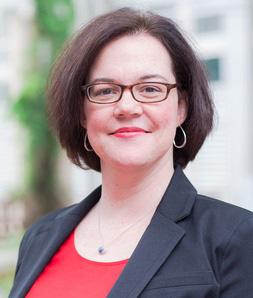
ASTRO
Registration Deadlines
Advance: June 30–August 17, 2023*
Standard: After August 17, 2023
The ASTRO 2023 program will take place Saturday, September 30–Wednesday, October 4. For more information on the program and the schedule, please visit our Learn page.
The deadline to reserve housing is Thursday, September 7 at 5:00 PM, ET. Inventory is limited, so be sure to book early!
www.aapm.org | 47 AAPM Newsletter | September/October 2023 Volume 48, No. 5
AMERICAN SOCIETY FOR RADIATION ONCOLOGY (ASTRO) REPORT , Cont.
Monday, October 2, 2023
Bill Salter, PhD, Huntman Cancer Institute at the University of Utah, leads Panel 10 — Challenging Cases in Patient Safety: The Nation's Experience Navigating New Technologies as Told to RO-ILS. During the session, an interdisciplinary panel will discuss how they would approach these safety events and associated themes. Attendees will leave with an enhanced understanding of how to approach errors reported from across the country and have practical ways to implement process changes in their practice to improve patient safety.
Carri Glide-Hurst, PhD, University of Wisconsin, moderates QP 03 — Phys:1 Segmentation, including five presentations covering adaptive segmentation of OARs in MRI-based radiation therapy, automated dosimetric analysis, and crowdsourcing deep learning algorithms for autocontouring.
Rojano Kashani, PhD, University Hospitals Seidman Cancer Center, leads EDU 13 — Clinical Considerations and Practical Approaches to Re-Irradiation. This session identifies safe approaches and potential gaps in different approaches to specification of dose limits, dose forgiveness and other considerations in re-irradiation.
James Balter, PhD, University of Michigan, and Wensha Yang, PhD, University of California San Francisco, comoderate six different presentations in SS 10 — Phys 2: Best of Physics.
Geoffrey Hugo, PhD, Washington University St. Louis, and Brian Winey, PhD, Massachusetts General Hospital comoderate SS 12 — Phys 3: FLASH and Novel Techniques.
Lianli Liu, PhD, Stanford University, and Kristy Brock, PhD, FASTRO, MD Anderson Cancer Center, co-moderate SS 16 — Phys 4: Motion Monitoring and Deep Learning.
Tuesday, October 3, 2023
Jay Shelton, MD, Edward C. Loughlin Radiation Oncology Center, leads an interdisciplinary panel discussion in Panel 17 — Change for the Better: Lessons from APEx. This session will present case studies from clinicians at multiple practice types, discussing the importance of assessing and standardizing processes using APEx.
Hina Seed, MD, Baptist Health South Florida, and Kristy
Brock, PhD, FASTRO, MD Anderson Cancer Center, comoderate five different presentations in SS 18 — Dose homogeneity index (DHI) 2
Jean Moran, PhD, Memorial Sloan Kettering Cancer Center, and Naomi Schechter, MD, RMI, SFPTI, co-moderate a safety focused quick pitch session in QP 14 — Patient Safety 1. Five presenters will provide an overview on topics such as leveraging real-time machine learning, automatic contour quality evaluation, the use of FMEA with the Six Sigma framework, and others.
Richard Popple, PhD, University of Birmingham, presents Panel 16 — Challenges to Automation of Clinical Workflows. During the session, five physicists will share their experiences implementing automation in their clinics, with a focus on the challenges encountered and strategies to mitigate them.
Lei Ren, PhD, University of Maryland, presents EDU 24 — Evolving Roles of Medical Physicists in Clinical Trials. This session will review the various roles of medical physicists in clinical trials and offer insight into how to best integrate physicists' expertise to maximize the quality and efficiency of the trials.
Wednesday, October 4, 2023
Laura Freedman, MD, University of Miami, and Naomi Schechter, MD, RMI, SFPTI, co-moderate SS 33 — Patient Safety 2, covering topics like quantitative and qualitative impact of CT-based radiation therapy dose maps and treatment terminations during radiation.
Master Classes
Master Classes are deeper dives into a particular topic that require additional time and instruction. This year ASTRO will hold four Master Classes covering a wide range of topics. To register for any Master Class, please select the class you would like to attend during the registration process. If you have already registered to attend the meeting and would like to add a Master Class, you may modify your registration to include it.
Saturday, September 30, 2023
Master Class: Advanced Quantitative Imaging Techniques for Personalized Radiotherapy and Lung Toxicity Avoidance — 1:00 PM–3:00 PM.
48 | www.aapm.org AAPM Newsletter | September/October 2023 Volume 48, No. 5
AMERICAN SOCIETY FOR RADIATION ONCOLOGY (ASTRO) REPORT , Cont.



Master Class: Safety Is No Accident: Building Inclusive Cultures — 1:00 PM–3:00 PM.
Master Class: Radiopharmaceutical Therapy — 1:00 PM–5:30 PM.

Sunday, October 1, 2023







Master Class: Beyond RTOGv2.0: The First Ten Years of NRG Oncology and Paying It Forward for Many Years Ahead — 4:15 PM–5:45 PM.

Meeting Highlights

ASTRO 2023 has been uniquely designed to ensure that attendees from around the world continue to access timely scientific and educational content. The Presidential Symposium will highlight the meeting theme of Pay it Forward: Partnering with Our Patients, focusing on the patient perspective and engagement to develop and advance research by elevating clinical trials and addressing the integral role of research in patient care. The PRO program will provide curated content addressing topics of interest to those in community practice. The Cancer Breakthroughs and Science Highlights sessions have been expanded to provide attendees with the latest science available. Storytelling sessions will highlight various topics from patient perspectives to parental leave to data breaches and more.
Keynote Speakers:
Monday, October 2 — Arif Kamal, MD, MBA, MHS, FACP, FAAHPM, FASCO, is the Chief Patient Officer at the American Cancer Society. In this newly created role, Dr. Kamal drives coordinated efforts to accelerate progress against cancer through the organization’s patient-, caregiver- and health care professional-facing activities.
Tuesday, October 3 — Anupam Bapu Jena, MD, PhDBased on his book, co-written with Christopher Worsham, “Random Acts of Medicine: The Hidden Forces that Sway Doctors; Impact Patients, and Shape Our Health,” Dr. Jena will explore how natural experiments — random events that unknowingly turn us into experimental subjects — can show us how our health is shaped by forces invisible to the untrained eye.
Continuing Medical Education for Physicists
For CME credits, an application will be submitted to the Commission on Accreditation of Medical Physics Education Programs (CAMPEP) for Medical Physics Continuing Education Credits. CAMPEP credits must be claimed by November 3, 2023. Any credits claimed after the evaluation deadline will not be submitted to CAMPEP.



ASTRO looks forward to seeing you in San Diego. ¢

www.aapm.org | 49 AAPM Newsletter | September/October 2023 Volume 48, No. 5
Save the Date!
Expanding Horizons TRAVEL GRANT
The EXPANDING HORIZONS TRAVEL GRANT program is designed to provide students and trainees with an opportunity to broaden the scope of scientific meetings attended in their career. The proposed meeting should introduce new and relevant topics which may ultimately be incorporated into current or future medical physics research and progress the field in new directions.
Program Year 2024 will be broken into two application cycles: Spring (Round 1) and Fall (Round 2).
The total amount of support funding for use towards travel and/or meeting registration will be based on attendance type: $1,250 if attending IN-PERSON or $500 if attending VIRTUALLY/ONLINE ONLY
Please Note: $250 of the total award amount regardless of attendance type is contingent on a short presentation given by awardee at the next available AAPM Annual Meeting & Exhibition.
IMPORTANT SPRING DEADLINES
Open: August 1, 2023
Deadline: September 30, 2023
Award Decisions: November 1, 2023
REQUIRED DOCUMENTS
Cover Letter/Personal Statement
• Long-term career goals
• Motivation to attend proposed meeting
• Expected scientific value of attendance on dissertation project or future research
Curriculum Vitae
• Limit to education, publications, presentations, and any relevant awards
Letter of Recommendation
• Must also confirm that additional expenses outside of total award amount will be covered
Budget/Overall Expected Expenses
ELIGIBILITY CRITERIA
Proposed meeting cannot be specifically related to medical physics.
Proposed meeting must take place between January 1 – June 30, 2024.
Must be a current graduate student, post-doctoral candidate, or current resident within five years of graduation at time of submission.
Must be an AAPM member in good standing at the time of submission.
Must not be a past Expanding Horizons awardee.
EXAMPLES OF INELIGIBLE MEETINGS
Any AAPM-sponsored meeting
American Society of Radiation Oncology (ASTRO) Annual Meeting
Radiological Society of North America (RSNA) Annual Meeting
Any meeting regularly attended by institutional group/ program (judged on case-by-case basis)
Any meeting that has previously been supported by an Expanding Horizons Travel Grant under the same Faculty/Advisor/Principal Investigator
APPLY TODAY: gaf.aapm.org/#EXHG QUESTIONS? exhg@aapm.org | www.aapm.org
2024
AAPM
Boycott of the 2023 Annual AAPM Meeting in Texas and Future Plans

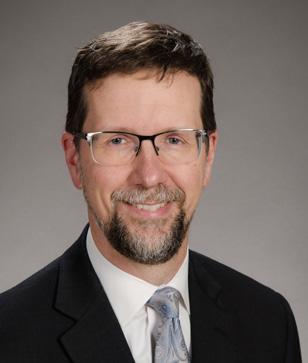
MEMBER VOICES ON ANNUAL MEETING BOYCOTT


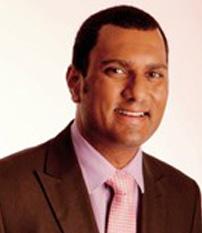
Total registration numbers for in-person attendance were lower compared to pre-pandemic numbers (see Table 1). In this article, several individuals share their reasons for boycotting and their hopes for the AAPM and future decisions about meeting locations.
Boycotts have been utilized throughout history as a part of social, political, and moral movements such as the American civil rights movement and farm worker union protests. Many individuals boycotted the 2023 AAPM Annual Meeting in Texas. Total registration numbers for in-person attendance were lower compared to pre-pandemic numbers (see Table 1). In this article, several individuals share their reasons for boycotting and their hopes for the AAPM and future decisions about meeting locations.
Why did you boycott the annual AAPM meeting in Texas this year?
Kristi Hendrickson:

I felt compelled to boycott the AAPM Annual Meeting hosted in Texas in support of AAPM members who do not feel safe traveling to Texas because of the laws limiting women’s healthcare. This circumstance violates my values of equitable access to the professional and career-advancing opportunities that the Annual AAPM Meeting provides in abundance. A 2023 survey of students and trainees in medical physics shows that younger members of our field are concerned about this issue. The survey asked how changes in abortion legislation affected their decision to attend conferences or meetings in certain states. Forty percent of respondents agreed that abortion legislation affected their decisions; 34% disagreed (see Figure 1). Additionally, I am concerned about the impact that these laws have on cancer patients, limiting their
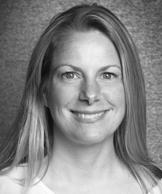
www.aapm.org | 51 AAPM Newsletter | September/October 2023 Volume 48, No. 5
Kristi Hendrickson, PhD, FAAPM University of Washington
Kelly Kisling, PhD UC San Diego
Indrin J. Chetty, FAAPM
Henry Ford Health System
Eric C. Ford, PhD, FAAPM University of Washington Medical Center
Lindsay E. Jones, MS Timothy D. Solberg, PhD, FAAPM, FACMP University of Washington
Registration Numbers for Scientific Attendees/ Speakers In-Person / Virtual Total Membership Percentage of Total Membership 2023 Houston 2913 / 421 9974 33% (29% in person) 2022 Washington DC 2425 / 779 9762 33% (25% in person) 2021 Virtual 0 / 3212 9521 33% 2020 Virtual 0 / 3677 9266 40% 2019 San Antonio 4060 / 0 8886 46% 2018 Nashville 4435 / 0 8931 50%
Mark P. Supanich, PhD, FAAPM Rush
MEMBER VOICES ON ANNUAL MEETING BOYCOTT , Cont.
ability to make their own healthcare decisions when their cancer coincides with pregnancy. I respect the decision of individuals who decided to attend this year’s AAPM Annual Meeting in Texas. I acknowledge my privilege at this stage of my career to boycott with fewer ramifications than others may experience. My not attending does not in any way diminish my intention to be involved in AAPM. I expect to continue my involvement in AAPM and work toward an organization that empowers all individuals in medical physics to thrive.
to mention untold pain and anguish for these people and families. I believe that a woman alone has the right to her health and well-being, a view held by both the majority of Americans and the majority of Texans. I will not in any way support a state that restricts access to healthcare (or, for that matter, legislates any other form of inequity). My Texas Medical Physics license, #0072, has not been renewed.
Indrin Chetty:
I boycotted because I refuse to spend my dollars in states that violate human rights.
Mark Supanich:
I decided to boycott the meeting in Texas to both stand in solidarity with the AAPM members who didn't feel safe traveling to Texas and to refuse to directly contribute to the economy of the state (for travel/reasons under my control). While I believe that all the abortion bans and restrictions that have been implemented since the Dobbs decision are heinous limitations on fundamental healthcare rights, the Texas law's civil penalty provisions are particularly egregious. I hope that by boycotting the meeting and publicizing my reasons for doing so that I contribute in some part to continuing the conversation within AAPM on this issue. Furthermore, I hope that the voices of those who boycotted are heard by the AAPM Meeting Coordination Committee and the Board of Directors, and that they consider these factors when planning future AAPM meetings.
Eric Ford:
Tim Solberg:
While several states have placed significant restrictions governing reproductive rights, laws in Texas are truly draconian. Prior to the decision in Dobbs v. Jackson, the Texas legislature passed SB 8, prohibiting abortions after the detection of embryonic cardiac activity, typically around the sixth week of pregnancy. Texas subsequently passed a trigger law that took effect with the Dobbs decision, outlawing abortion except at the risk of death. A doctor who performs an abortion is now subject to a felony charge punishable by up to life in prison. Concerns are not hypothetical; they are real. Doctors are reporting more frequent first and second-trimester complications, including deaths from sepsis. Pregnant people are now required to carry non-viable fetuses to term, resulting in an infant mortality increase of 11.5% for 2022 compared to 2021, not

My decision not to attend the annual meeting hinged on the Dobbs decision and its impact. Texas now has some of the most restrictive access to abortion. Holding a meeting in Texas, in particular, seemed unwise and unnecessary. Regardless of how any of us feel about the issue of abortion or reproductive rights, there is no denying the reality of the negative impacts that restrictive access has on patients and our members. AAPM organizers made their choice to meet in Texas. I made my choice not to attend. I appreciate having a choice.
Kelly Kisling:
I boycotted to stand in solidarity with Texans who no longer have access to necessary reproductive healthcare and who may be forced to carry pregnancies to term against
52 | www.aapm.org AAPM Newsletter | September/October 2023 Volume 48, No. 5
Figure 1. Results of the 2023 Equity, Diversity, and Inclusion Climate Survey for Medical Physics Students and Trainees conducted by the American Institute of Physics on behalf of AAPM and the Canadian Organization of Medical Physicists.
their will. I also stand with our colleagues in Texas who now face the threat of severe penalties for delivering evidencebased care. Yet boycotting alone is not enough. We must continue to advocate for access to safe reproductive healthcare, including abortion. The Hysterical Movement was founded to advocate with the mission to (1) educate the public and healthcare professionals on the impacts of restrictions to reproductive healthcare on our colleagues and patients and (2) encourage professional societies and healthcare professionals to promote equitable access to reproductive healthcare.
Lindsay Jones:
Disability is the only marginalization that intersects with every other one. I stand in solidarity with AAPM members who boycotted the annual meeting this year because of the dangerous lack of full-spectrum reproductive health care available in the state of Texas for women, non-binary folks, and trans men.
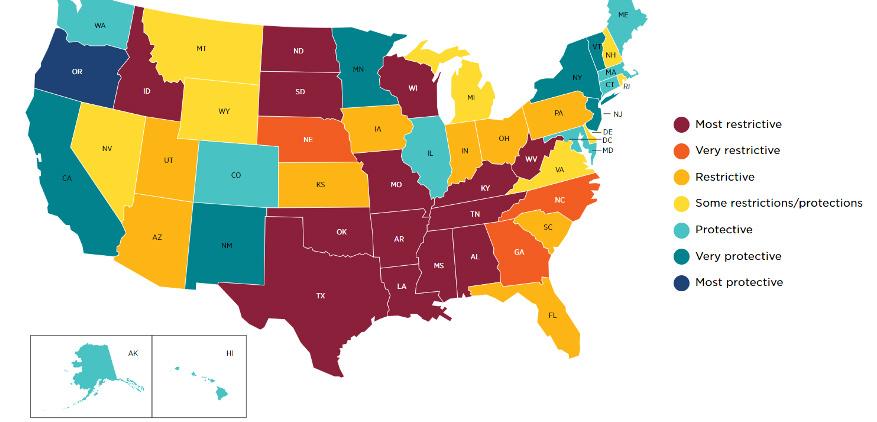
Why are these issues relevant to AAPM?
Eric Ford:
The issue is highly relevant to almost all professional medical associations, and many, like the American Medical Association, have issued strong statements condemning the Dobbs decision. The American College of Obstetrics and Gynecologists relocated its April 2023 conference slated to be held in Louisiana due to trigger laws that ban abortions. This year, the American College of Radiology passed Resolution 11, opposing the criminalization of physicians and other medical professionals who seek to provide evidence-based care to patients, including abortion. It is difficult to see how the Dobbs decision is consistent with the AAPM strategic mission, namely to "... advance medicine through excellence in science, education and professional practice of medical physics..." Access to reproductive technologies, including abortion, is medically necessary for our patients. For more context on this and the impact on patients, see the article from Evans et al (https://pubmed.ncbi.nlm.nih.gov/35963470/) and the updated graphic from that paper shown in Figure 2. Unfortunately, you cannot both strive for "excellence in practice" and support the Dobbs decision at the same time.
Secondly, AAPM has a duty to protect the health and safety of attendees at meetings. Having the meeting in a state that restricts access to reproductive healthcare means that attendees who are pregnant must accept a potentially catastrophic risk if a reproductive health emergency were to arise during the meeting. Colleagues I have talked to expressed that if they were pregnant, they would not feel comfortable or safe attending a meeting in a state with restrictive laws.
Kelly Kisling:
We are healthcare professionals and abortion is an essential component of healthcare for our patients. Thousands of pregnant people receive a cancer diagnosis each year. As such, I believe that AAPM has an important role in promoting access to reproductive care, especially given our unique perspective of how this impacts cancer treatments and diagnostic imaging. And this work aligns with our mission: "promoting the highest quality medical services for patients." We cannot provide the highest quality care to patients if we deny them the option of an abortion.
What actions do you hope to see AAPM take?
Indrin Chetty:
AAPM choosing not to offer a virtual meeting is highly disappointing. I would have preferred for the meeting not to be held in Texas. However, I am considerate of the multitude of factors pertaining to venues booked in advance. The lack of a virtual format option sends a
www.aapm.org | 53 AAPM Newsletter | September/October 2023 Volume 48, No. 5
ANNUAL
MEMBER VOICES ON
MEETING BOYCOTT , Cont.
Figure 2. This map categorizes states based on abortion policies they currently have in effect. Used with permission from the Guttmacher Institute. Data current on 8/3/2023.
message that AAPM will not support us. This type of action appears to be in direct contradiction with the “inclusivity” statements touted all over the AAPM website. It is, in fact, exclusive. Therefore, at the very least, a virtual format option is necessary for future meetings.
Eric
Ford:
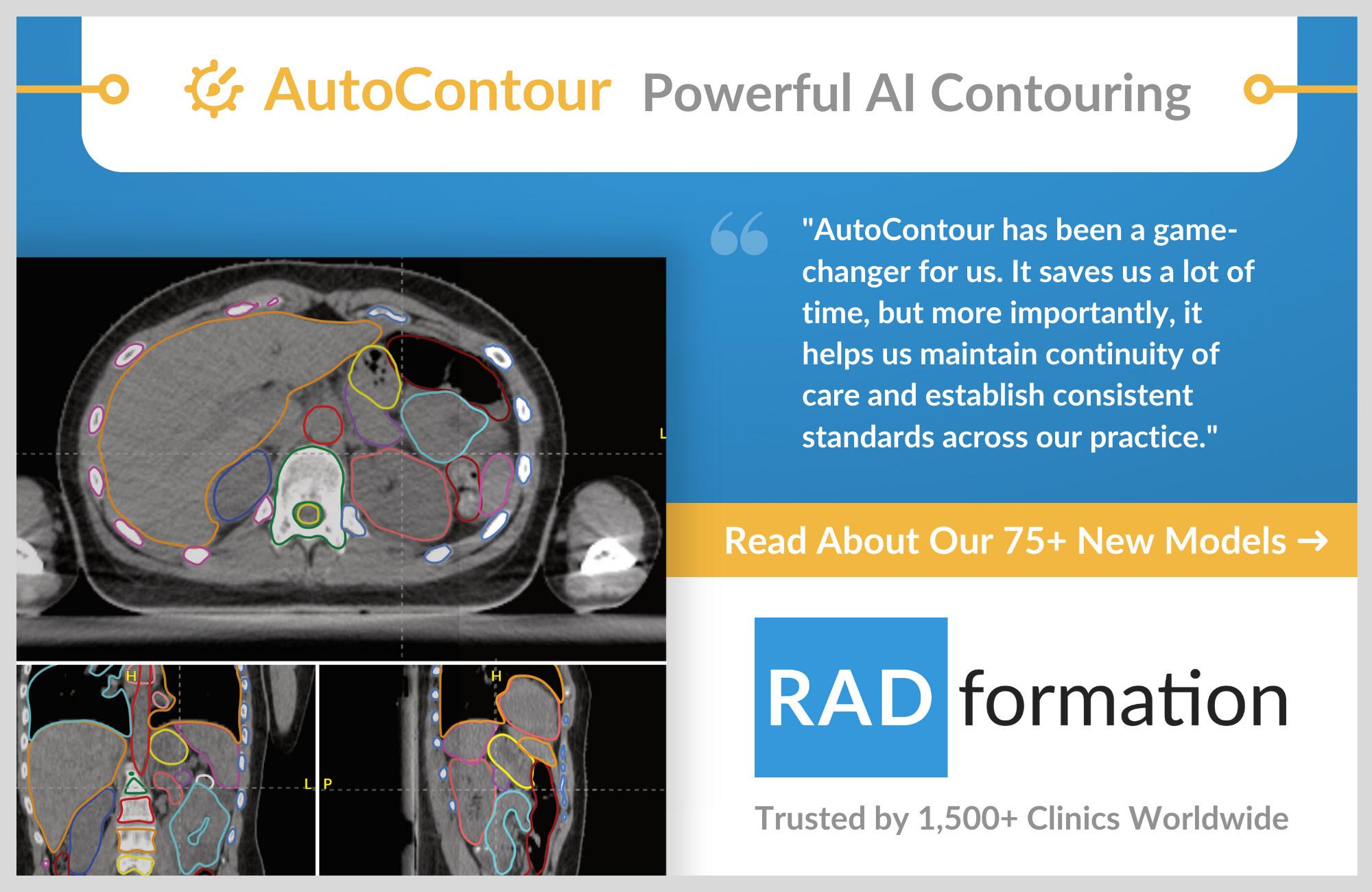
In the interests of our patients and our members, I believe AAPM needs to take a firm stance against restricting access to reproductive healthcare including abortion. The statements that AAPM has issued thus far are a good first step. Actions are needed as well. I believe AAPM had a choice to organize the meeting in another state this year. I advocated for this as did others I know. It is incumbent on AAPM leaders (who are more senior and more male) to fully consider the burdens that restrictive reproductive healthcare places on patients and attendees who are more junior and female. More action is needed. One action that lies firmly in control of AAPM is to no longer hold the annual meeting in states which restrict access to reproductive healthcare, including abortion.
Kelly
Kisling:
AAPM is uniquely positioned to expose the negative impacts these laws have on our patients and members from a medical physics perspective. I applaud the statement they released last year. However, one-time statements are not enough to enact the changes that are desperately needed to save lives. Moving forward, AAPM could continue to bring our profession’s perspective on the impact of anti-abortion laws on healthcare to the public and policy-makers. While AAPM has no official advocacy arm, we can support our partner societies, including ASTRO and ACR, in such efforts. Also, rather than shy away from difficult issues, AAPM has an opportunity to foster productive discussions, especially when these topics affect our ability to care for our patients. A common theme that we as clinicians and scientists can coalesce around is the goal of bringing evidence-based care to our patients. I hope AAPM considers taking more action to address these dangerous anti-abortion laws. After all, who will advocate for our patients if not us? ¢
MEMBER VOICES ON ANNUAL MEETING BOYCOTT , Cont.
Heard — Listened — Now Reflecting on How We Can Create “Safe Space” Within Medical Physics
AAPM PROFESSIONAL BEHAVIOR
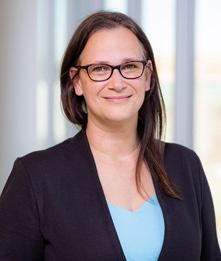
What we heard (directly or anecdotally) led us to write this essay to acknowledge how one’s behavior, actions, inaction, and words affect our community.
Medical physics is focused on precision measurements, accurate equipment performance, and scientifically sound methodology. As medical physicists we must have the skills and knowledge to perform these tasks. Scientific expertise is necessary but not sufficient for one to be a good medical physicist.

We are not only scientists. We are also mother, father, daughter, son, cousin, friend. We are religious community members, athletes, musicians, and artists. Our recent annual meeting theme highlighted the relationship between art and science to research done. Research is emerging into how medical physicists can learn communication skills to improve patient care. We are recognizing that our humanity makes us better physicists.
In addition to improving science and patient care, who we are as individuals affects our professional relationship with each other. Our interactions with colleagues matter. A positive interaction with a colleague can build selfconfidence and a sense of community, which contribute to professional and personal well-being. A negative interaction can cause poor overall job satisfaction and diminish professional motivation and involvement. This becomes even more critical when the person on the receiving end is in graduate school, residency training or early in their careers. We each — to some degree — have experienced this.
We (the authors drafting this as fellow citizens and not in our leadership roles in AAPM) often reflect on the importance of fostering positive interactions among members of the medical physics community, and humbly ask: how can we do better, individually? What can we do to increase the likelihood that all medical physicists can co-exist with colleagues in a mutually respectful atmosphere? What can we do to foster the environment we strive to create and speak out against negative behaviors?
There are some standards that can help guide us in reflecting upon our own behavior, but also serve as a benchmark for how we expect to be treated by colleagues. At our individual jobs. At professional meetings. During work dinners or the annual Night Out. At the root is a respect of colleagues’ boundaries, both physically and conversationally. This branches out to acknowledging that our colleagues’ values and past experiences may be vastly different from our own, understanding that even if our comments are not directed at a coworker, using derogatory language to describe a service engineer, nurse, etc., reflects poorly on our respect for other people in general. If we are acting in a supervisory role, we need to recognize that
www.aapm.org | 55 AAPM Newsletter | September/October 2023 Volume 48, No. 5
Rebecca Milman, PhD, FAAPM University of Colorado School of Medicine
M. Mahesh , PhD, FAAPM Johns Hopkins University School of Medicine
power dynamics are real — if we control someone’s work schedule, salary, or job security, their ability (both real and perceived) to express a dissenting opinion is limited. Each of us needs to hold ourselves accountable. We humbly ask everyone to contemplate these points with the







goal of treating others the same as we like to be treated. Medical physics should be a community where anyone who works to improve human health through medical physics can feel they are treated with dignity and respect.




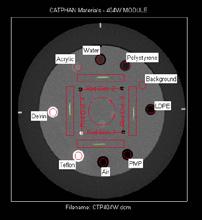
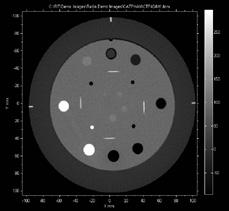

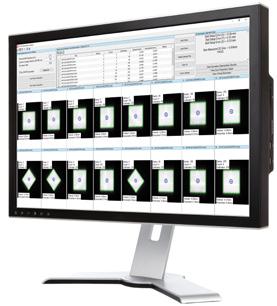


56 | www.aapm.org AAPM Newsletter | September/October 2023 Volume 48, No. 5 AAPM PROFESSIONAL BEHAVIOR , Cont.
¢
The North Central Chapter of the AAPM Celebrates its 50th Anniversary at its Fall Meeting


AAPM NCC REPORT
The North Central Chapter of the AAPM (NCC AAPM) was officially established in 1973. In those days, the AAPM met in conjunction with the meeting of the Radiological Society of North America (at the Palmer House Hotel) but in the Blackstone Hotel (long before it was closed for health violations and a very long running labor action and turned into high-end condominiums).
At the meeting in November of 1970, medical physicists from the northcentral region formed an exploratory committee to consider forming an AAPM chapter. The committee determined that forming a chapter would be desirable and sent a Call to Action to all medical physicists in the potential chapter states (Minnesota, North Dakota, South Dakota and Wisconsin) to assess interest in doing so (Figure 1). The response was strongly in favor of forming the chapter and led to the official proposal for the chapter formation in November 1973 (Figure 2). The members of the chapter met in December 1973 to discuss the constitution and by-laws, geographical coverage as well as the first official meeting (Figure 3).
To give some historical perspective to when the North Central chapter was formed:
1. In radiotherapy (and it was called that in those days),
• Treatment units were mostly cobalt and some 4-MV linacs, (Cs-137 and Orthovoltage x-ray treatment units were very rare by this time.)
• Most planning (if done) used manually taken contours and hand combined isodose curves,
• Brachytherapy used radium, cobalt and radon; Cs-137 just coming into use.
2. In diagnostic,
• The workhorses were x-ray units and fluoroscopy, which used analog TVs or fluorescent panels,
• Head CT just came out in 1972 and very few were in use; whole-body CT was developed in 1973.
3. In nuclear medicine,
• Tc-99m was well established for brain, just moving into liver; 131I still common for liver, thyroid,
Ashley Tao, PhD 2023 NCC-AAPM
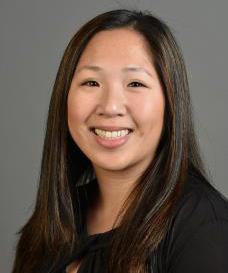
President
Bruce Thomadsen, PhD, FAAPM
2018 AAPM
President, 2001 NCC-AAPM
President
Larry DeWerd, PhD, FAAPM

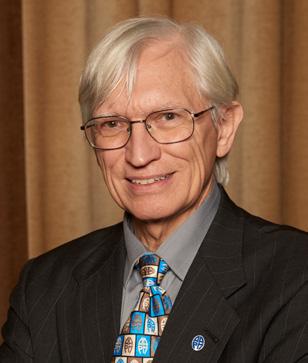
1991 NCC-AAPM
President
www.aapm.org | 57 AAPM Newsletter | September/October 2023 Volume 48, No. 5

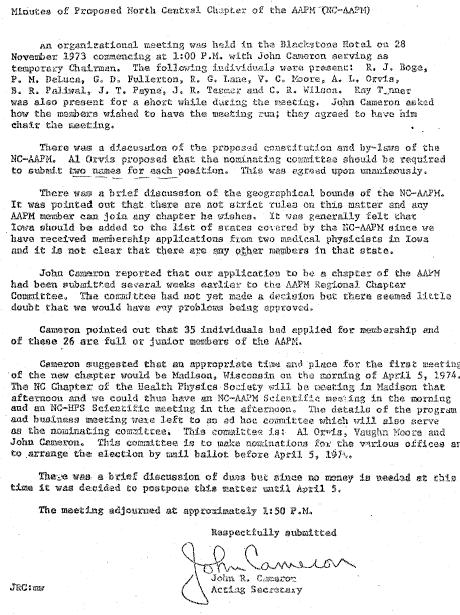

58 | www.aapm.org AAPM Newsletter | September/October 2023 Volume 48, No. 5 NCC AAPM CHAPTER REPORT , Cont.
Figure 2: Letter to potential members
Figure 2: Letter to potential members
Figure 1: Letter calling for the need of an AAPM chapter
• Rectilinear scanners were still the dominant imaging units; gamma-cameras were just coming into practices,
• Common therapies included 131I for thyroid and 32P for ovarian plural effusions and polycythemia vera.
4. Computers were just coming into use for radiotherapy treatment planning and nuclear medicine.
5. Quality assurance was not very common except for infrequent therapy calibration; the exception was nuclear medicine where it was needed weekly.
6. The most used journals for medical physics were Radiology, Acta Radiologica, The American Journal of Roentgenology Radium Therapy and Nuclear Medicine and The British Journal of Radiology
Looking at the journal in December of 1973, here is a list of some of the physics articles to give a flavor of the research topics of interest at the time.
Radiology
Autoradiographic Studies of Distribution in the Liver of 198Au and 99mTc-Sulfur Colloids: TK Chaudhuri, TC Evans, TK Chaudhuri
Weekly Total-Skin Electron-Beam Irradiation for Mycosis
Fungoides: LZ Nisce, GJ D'Angio, JH Kim
Comparative Beam Data for the 25 MV Betatron, 8, 6, and 4 MV Linear Accelerators, and 60Co Units: FK Chan, HR Haymond, AR Kagan, GE Carbone, FW George, III
A New 10 MeV Linear Accelerator for Radiation Therapy: CJ Karzmark, P Fessenden, DB Hughes
Effect of Fractionation on Skin Reaction in Tangential Breast Field 60Co Treatment: CM Mansfield, N Suntharalingam, DB
Leeper, S Kramer
Scintiphotography of Anger Camera Cathode Ray Tube
Displays: JT Payne, MK Loken, W Chandler
Transmission of Radiologic Information by Satellite: RG
Lester, F O'Foghludha, F Porter, DS Friedman, HR Pedolsky
Automatic Processor for Eastman Kodak Industrial X-Ray
Film, Type M (Estar Base): RL. Egan, GR Wright, DT Timms
Daily Reproducibility of Lung Blocks in the Mantle Technique: DL McCord, RR Million, MF Northrop, HVZ
Kavanaugh
Ultrasound in Diagnostic Medicine: EC Gregg, FL Thurstone, ER Epp
British Journal of Radiology
Computerized transverse axial scanning (tomography): Part 1. Description of system: GN Hounsfield
Computerized transverse axial scanning (tomography): Part 2. Clinical application: J Ambrose, BJ Perry, C Bridges
An experimental study of the dose distribution in water around 137Cs tubes used in brachytherapy: SC Klevenhagen
Accuracy in clinical dosimetry: PKI Kartha, A Chung-Bin, FR Hendrickson
Centenary celebration: William D. Coolidge
Acta Radiologica
Roentgen Area Product and Exposure Measurements during Chest Radiography and Nephrotomography: SC Bushong, MJ Pogonowska, AJ Gerlock, SA Glaze, DG Glaze
The North Central Chapter is home to many world-class medical physicists who have and are paving the field of medical physics. Below are some notable events in the chapter’s history:
• First CT in North America installed at Mayo Clinic (1973)
• Richard Mazess and John Cameron invented bone densitometry (1960’s), establishment of Lunar Radiation Corporation (now GE Healthcare Lunar) in 1973
• ADCL established at the University of Wisconsin by L. DeWerd in 1981 as an offshoot of the TLD program started in 1976.
• Chuck Mistretta (University of Wisconsin-Madison) was responsible for the development of digital subtraction angiography which was commercially introduced in 1980
• First independent Medical Physics department established at University of Wisconsin in 1981.
• High-dose-rate brachytherapy (commercially available mid-1980s) with first air kerma strength calibration at UW in 1986.
• Rock Mackie (University of Wisconsin-Madison) was the primary inventor of tomotherapy (1997). Founder of Tomotherapy Inc.
• The first photon counting CT in the world was installed at Mayo Clinic (2014)
www.aapm.org | 59 AAPM Newsletter | September/October 2023 Volume 48, No. 5
NCC
AAPM CHAPTER REPORT , Cont.
• University of Minnesota was the first in the world to perform human body MRI imaging at 10.5T (2018)

• Establishment of Radiation Measurements, Inc. (1974, became part of Gammex Inc. — which predated the chapter – and now part of Sun Nuclear), Standard Imaging (1989), Inc., Voximetry (2016)
• Notable textbooks originating from our chapter:
o Faiz Khan’s Physics in Radiation Therapy
o Frank Herbert Attix’s Introduction to Radiological Physics and Radiation Dosimetry
o William Hendee’s Radiation Therapy Physics
o John Cameron’s book on Medical Physics of the Body
o John R. Cameron, Nagalingam Suntharalingam, Gordon N. Kenney. Thermoluminescent Dosimetry. (TLD)
The chapter hosts two meetings per year, in the spring and fall. Most meetings are held over one day and occasionally add on a half-day symposium. The chapter supports our residents, post-docs, and students with the early career investigators competition and Med Phys Slam. Today, the North Central Chapter has over 330 members covering various disciplines within the field of medical physics.
The North Central Chapter will be celebrating the semicentennial of its formation October 19 and 20 at the Glacier Canyon Lodge & Wilderness Resort, in the Wisconsin Dells, a fun location for the whole family. Vist our website for more information and come be part of history. ¢
Advanced, Independent SRS & SBRT QA Solutions
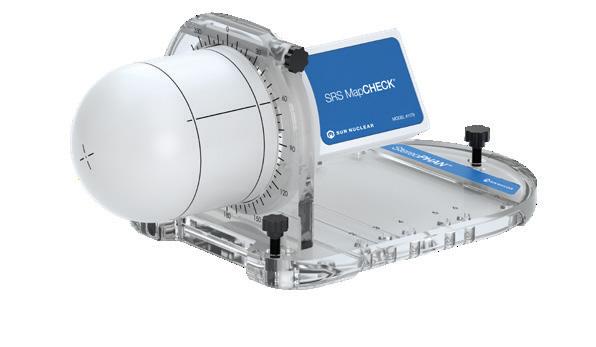

60 | www.aapm.org AAPM Newsletter | September/October 2023 Volume 48, No. 5
NCC AAPM CHAPTER REPORT , Cont. Meet the stringent demands of stereotactic treatments, with our suite of SRS/SBRT solutions. Explore our solutions: sunnuclear.com/srsqa
SunSCAN™
SRS
SRS MR Distortion Phantom sunnuclear.com The SunSCAN 3D system is not available in all markets. CE mark pending.
3D Water Scanning System
MapCHECK® & StereoPHAN
2023 William D. Coolidge Gold Medal Acceptance Speech
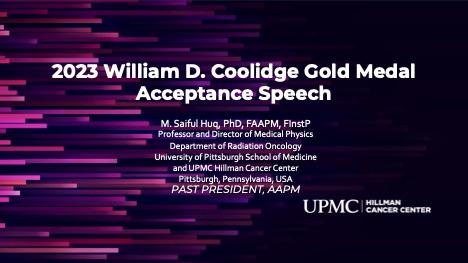
2023 AAPM AWARDS AND HONORS CEREMONY
M. Saiful Huq, PhD, FAAPM, FInstP Professor and Director of Medical Physics Department of Radiation Oncology University of Pittsburgh School of Medicine and UPMC Hillman Cancer Center
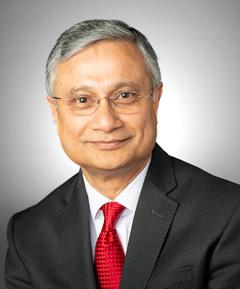
Thank you Sasa. My deepest appreciation to you for nominating me for this prestigious award and for the kind introduction. Your nomination, recognition and contribution to my professional journey have made this moment truly special.
EXCOM members, Chair of Awards and Honors Committee, Fellow medical physicists, ladies, and gentlemen:
I stand before you tonight with an overwhelming sense of humility and gratitude as I join the ranks of the giants in medical physics who have left an indelible mark on our field. I express my profound gratitude to the members of the Awards and Honors Committee and to AAPM for this humbling recognition. I vividly remember my first AAPM meeting, seeing my idols in the field receiving awards at this very ceremony, and being awestruck by their impact on this field. I aspired to be like them, and it is surreal to be on the other side now nearly three decades later. This award is truly a testament to the tireless efforts and unwavering dedication of the countless individuals who have supported me and guided me on this remarkable journey. You are my family, my friends, my residents, my students, my UPMC, Jefferson and AAPM family. You know who you are; you have been my pillars of strength, my source of inspiration. You have shaped me into the person I am today, and together, we pushed the boundaries of knowledge. Thank you.
I would be remiss not to acknowledge a few colleagues who have inspired me throughout my career and whose guidance, wisdom, expertise, and friendship have been instrumental in my growth as a medical physicist.
Drs. Ravinder Nath, Nagalingam Suntharalingam: Thank you for your mentorship early in my career.
www.aapm.org | 61 AAPM Newsletter | September/October 2023 Volume 48, No. 5
Dr. Jatinder Palta: Jatinder — You have been a true friend, someone I could always count on and collaborate with scientifically and professionally from day one of my professional life. Thank you.
Drs. Dave Rogers, Jan Seuntjens, Pedro Andreo, Carlos Almeida: your friendship and scientific collaboration have enriched my scientific career tremendously. Thank you.
Drs. Wilfred Ngwa, Stephen Avery: we have recently been dubbed the “Three Musketeers” throughout the world for our joint global initiatives. Thank you.
Dr. Heron: You were my partner for over a decade at UPMC managing the clinical services of the radiation oncology department. Thank you for your unparalleled support during those memorable years.
Renee Banaszewski, you have been my partner in crime every day. In a few months we will celebrate 20 years of working together. Without your support I would not be able to do what I do every day to manage a major medical physics organization at UPMC. Thank you.
Dr. Heath Skinner, my Chairman: you have made a special effort to be here with us tonight to celebrate this occasion. This speaks volumes about the genuine pride you hold for me and this special recognition. I am very grateful to you for this and for your unwavering support, both for me and for our Medical Physics Division. Thank you.
My AAPM family: You are the unsung heroes behind the scenes. Thank you for being there with me every step of the way from when I assumed the role of President in 2020 to today, receiving the Coolidge award. Thank you, Angela, Nancy, Corbi, Michael, Farhana, Lisa Schober, and all.
Angela: Special congratulations to you for your lifetime achievement award. I am so happy for you. Also, congratulations to all the award winners from tonight. We all are very proud of your accomplishments.
Dear colleagues: As I stand before you today, honored, and humbled, I am reminded of the profound impact that our field, and this organization, have on the lives of countless individuals affected by cancer. Let us strive to ensure that the benefits of medical physics – precision diagnostics, targeted treatments, artificial intelligence,
and enhanced patient safety — extend to regions in the world where they are most needed – the low- and middle-income countries. Together, as a global community of medical physicists, we can drive innovation, promote accessibility, and shape a future where no one is left behind in the pursuit of quality healthcare. AAPM is the largest and leading medical physics organization in the world. Therefore, by default, it has an ethical, moral, and humanitarian responsibility to lead and respond to the call for action in dealing with global health challenges that require medical physics expertise. The International Council, under the leadership of Dr. Jatinder Palta, is doing an amazing job in fulfilling this responsibility but can use more help. So, I ask all of you, especially our younger colleagues, to embrace this moment as a catalyst for action, as we work to advance medical physics in the service of humanity both in this country and around the world. Let this be a call to action — to engage, collaborate, and make a lasting difference in the lives of our patients. Together we can truly make a difference! None of my accomplishments would have been possible without the support of my family and loved ones. They have stood by my side throughout this journey, offering encouragement, understanding, and unconditional love. My parents and my elder brother: You would have been truly proud of me tonight. I know you are looking down on me from above. I know you are here in spirit, witnessing this momentous occasion. Tonight’s recognition is a testament to the values that you instilled in me. Your guidance, your wisdom, and your unconditional love continue to guide me, even in your absence.
My siblings, their spouses and all our eleven children. As we grew up together, we were a constant source of encouragement and support to each other. Our love and belief in each other’s abilities have always been a driving force in our pursuit of excellence. One of my brothers, Helal and his wife Lucy, are here to celebrate this moment with us. Thank you all.
Our beloved son Dr. Sakib Huq, soon to be a neurosurgeon, and his fiancé Dr. Nicole Fischer, the daughter we never had and soon to be an ObGyn physician, are here also to celebrate this moment. Sakib and Nicky, you are the embodiment of our hopes and dreams for the future.
62 | www.aapm.org AAPM Newsletter | September/October 2023 Volume 48, No. 5
2023 AAPM AWARDS AND HONORS CEREMONY , Cont.
Your unconditional love and your understanding of the sacrifices required in this field have been a constant source of inspiration for me. Your presence has brought immense joy into our lives. Thank you both for being beside us throughout this amazing journey. Finally, I will not be standing here tonight were it not for you Marian. I am who I am because of you. Your unwavering support, love, and understanding have been my rock throughout this journey. You have been my source of strength and encouragement, standing by me for 46 years, through highs and lows. It was you that encouraged me to enter this field of medical physics when we were just young adults learning how to navigate the world, and it is because of your support and encouragement that we
have been able to live the incredibly rich lives we have had. You are the best partner that a man can dream for. It is with deep sincerity that I say this gold medal truly belongs to you. Thank you my dear for being my partner, my confidante, my biggest cheerleader, my biggest champion.



In closing, I would like to reiterate my profound gratitude to all those who have been a part of my journey. The Gold medal award is not just a recognition of individual efforts but a celebration of the collective accomplishments of our field. Let us continue to work together, inspire one another, and strive for excellence as we shape the future of medical physics around the world.


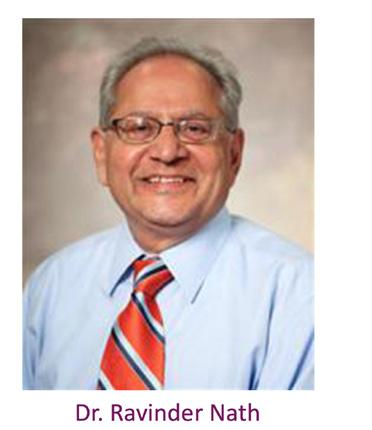

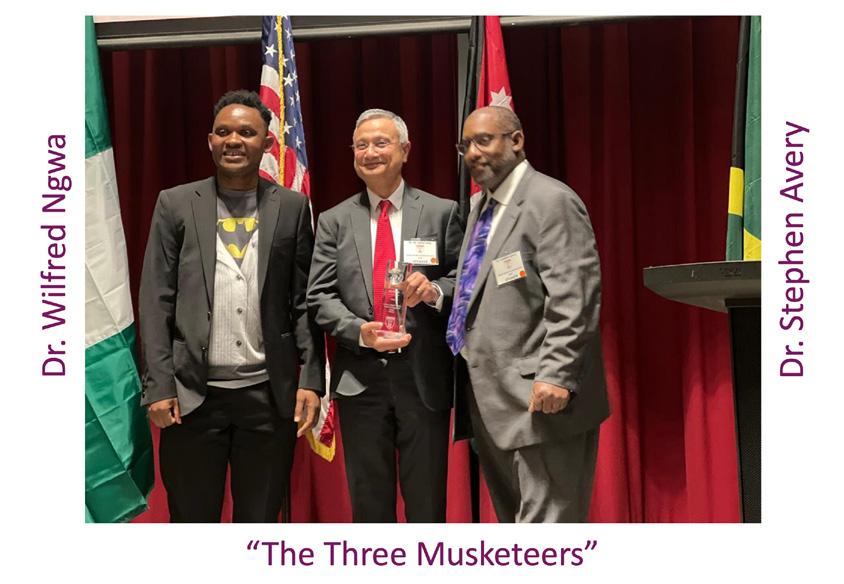
Thank you. ¢
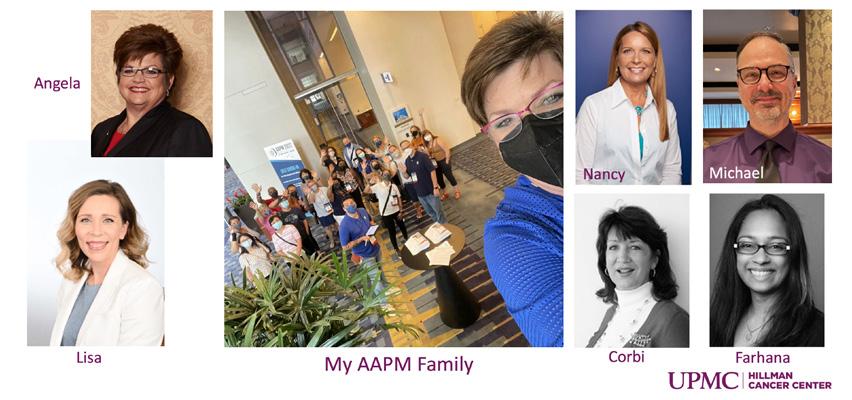
www.aapm.org | 63 AAPM Newsletter | September/October 2023 Volume 48, No. 5
2023 AAPM AWARDS AND HONORS CEREMONY , Cont.
1631 Prince Street, Alexandria, VA 22314 | p. 571-298-1300 • f. 571-298-1301 | aapm.org



























































 Robin Miller, MS | Northwest Medical Physics Center, Chair, PROFS
Robin Miller, MS | Northwest Medical Physics Center, Chair, PROFS























































 EDUCATION COUNCIL REPORT
EDUCATION COUNCIL REPORT








































































